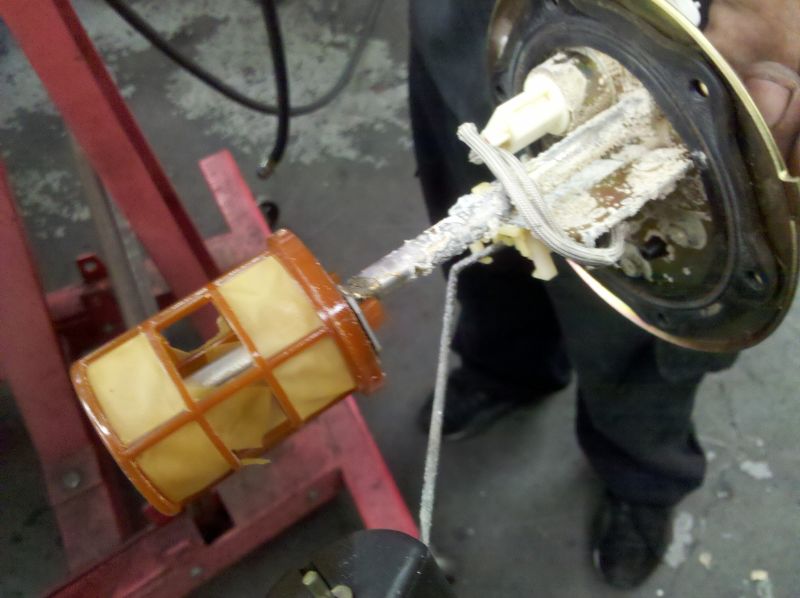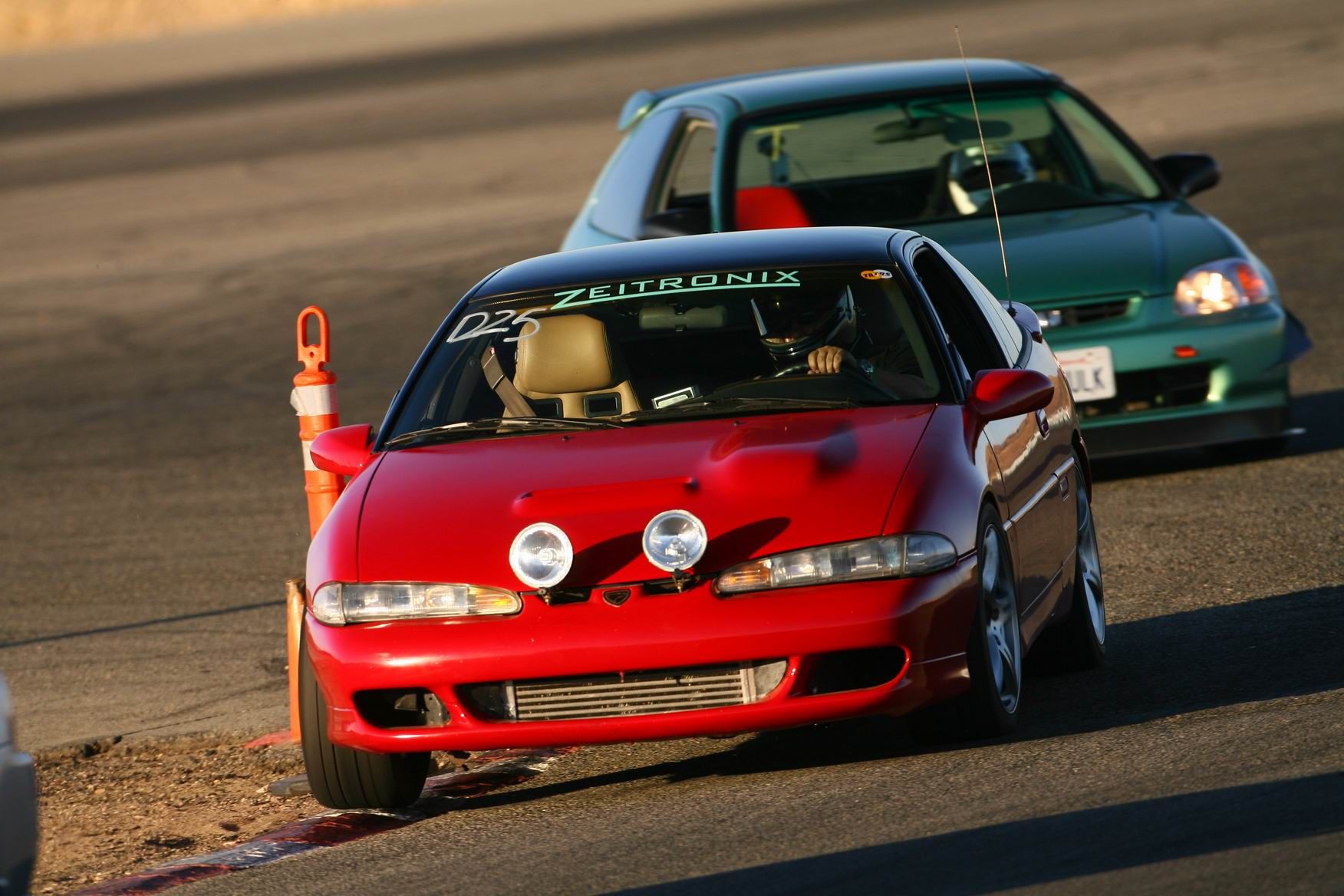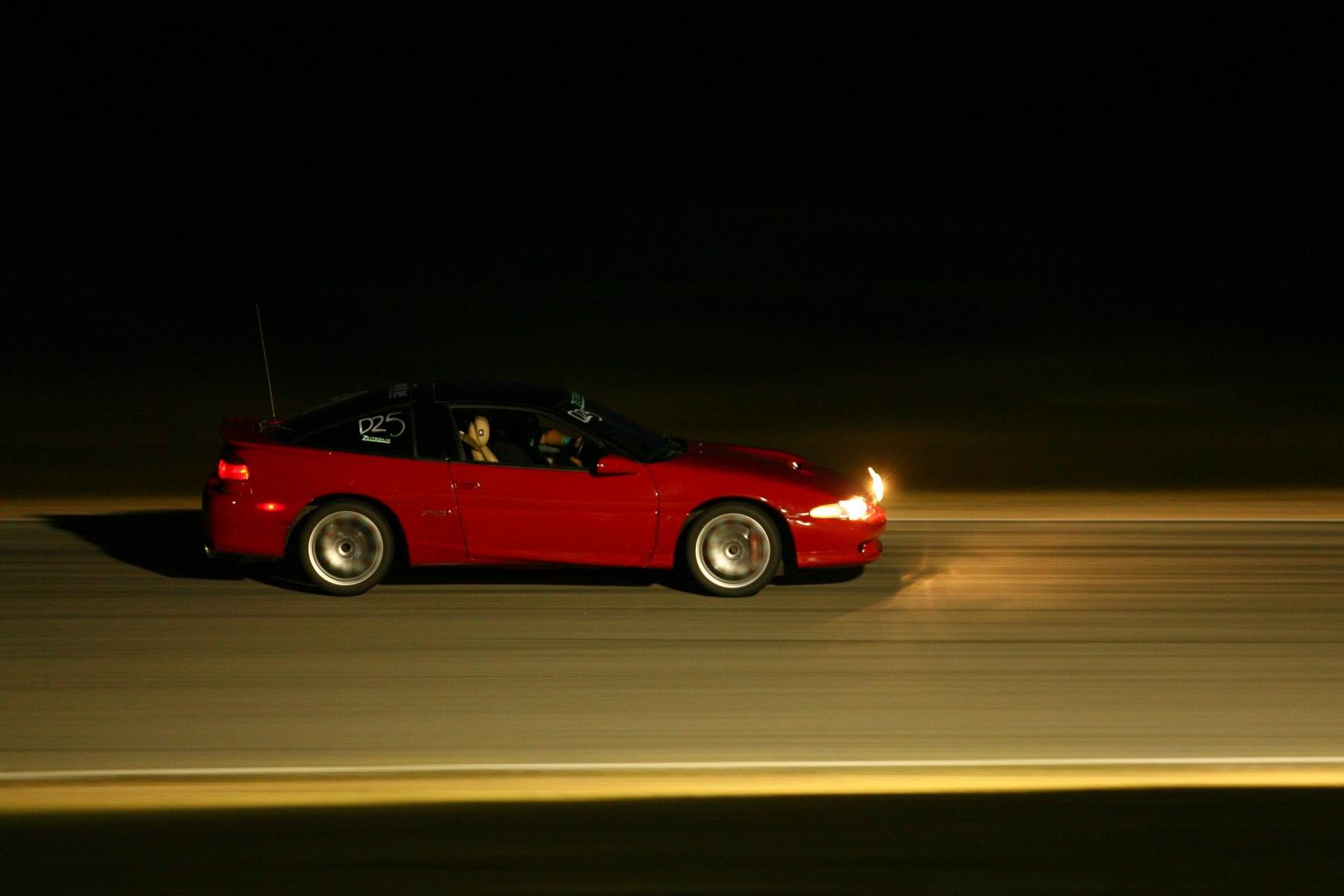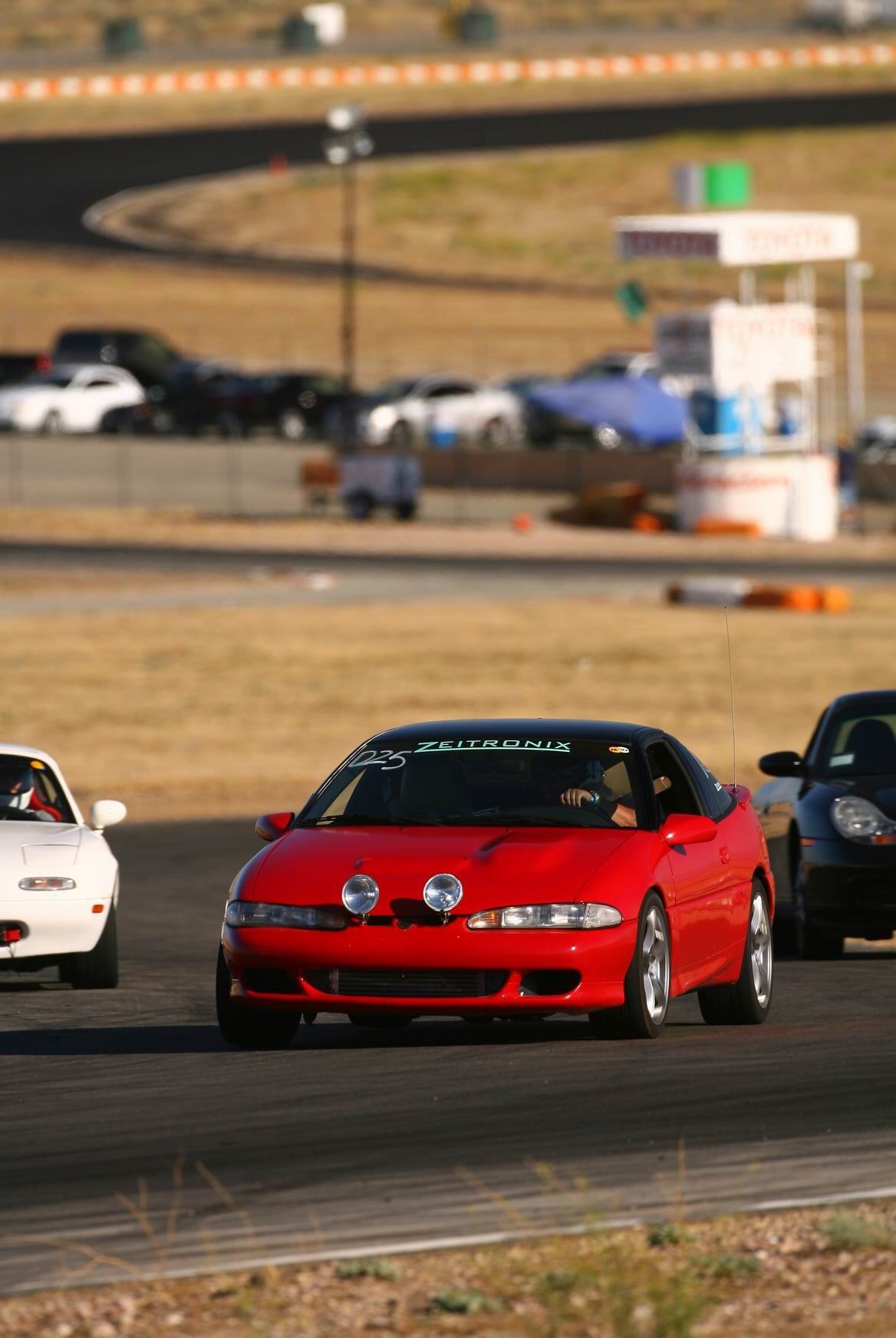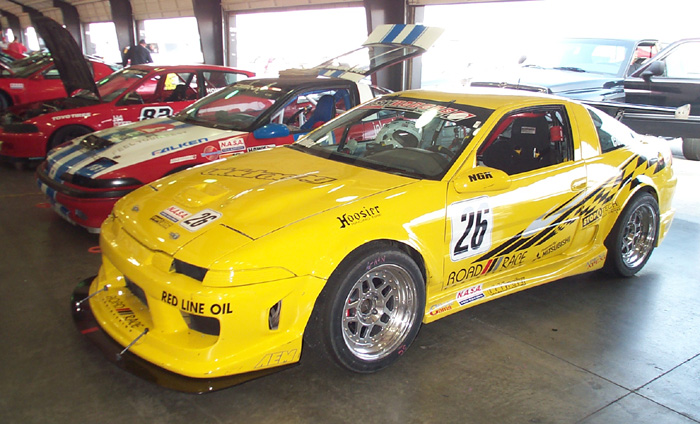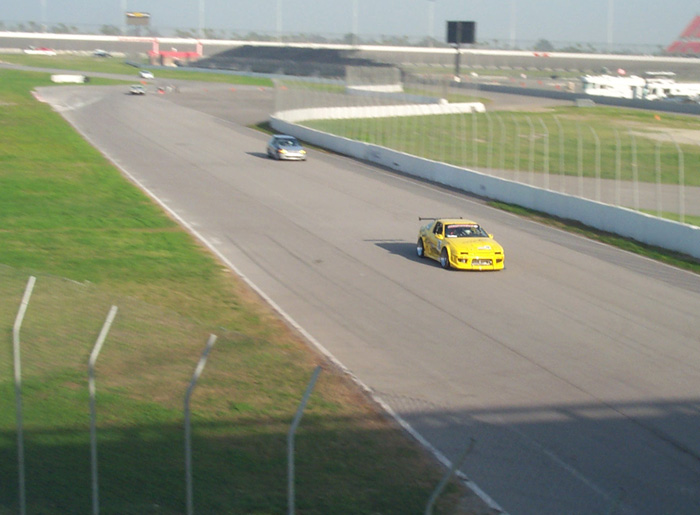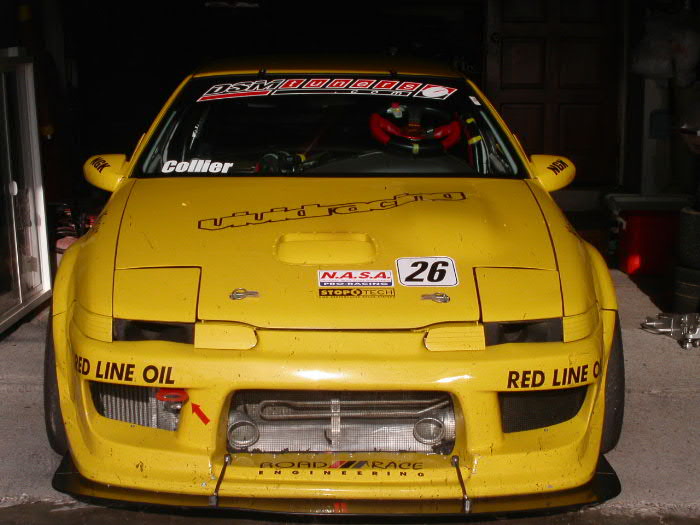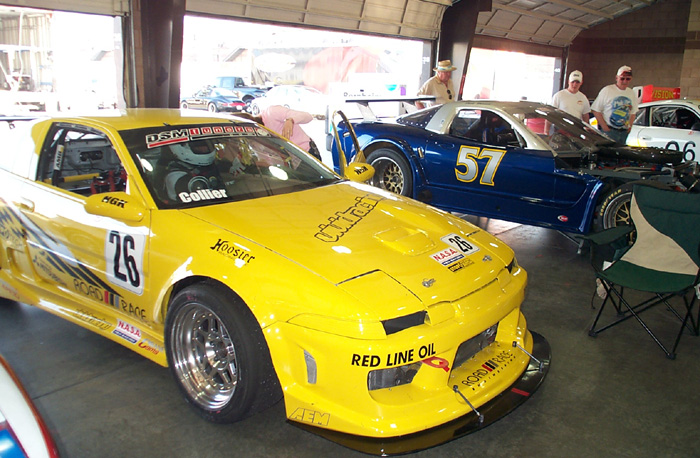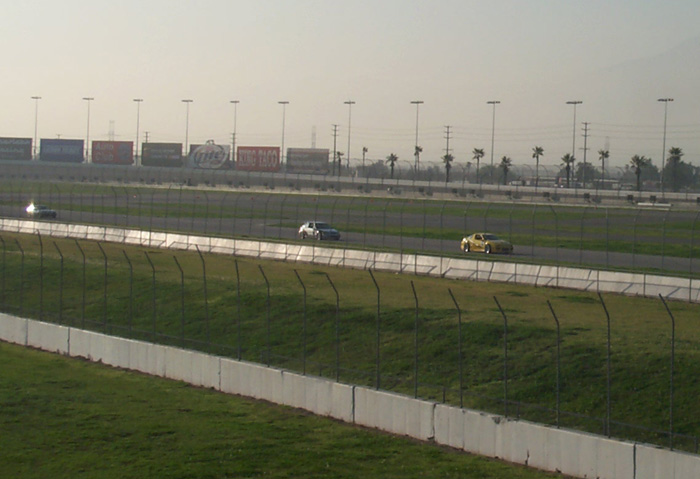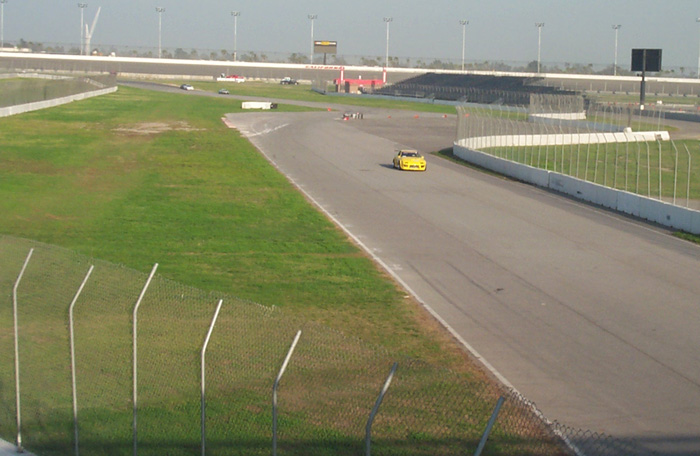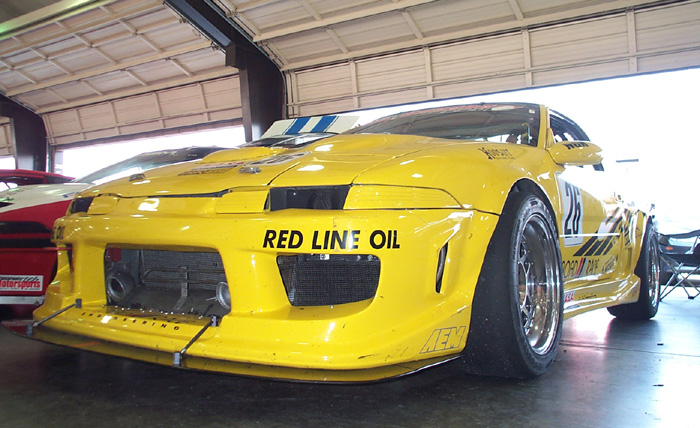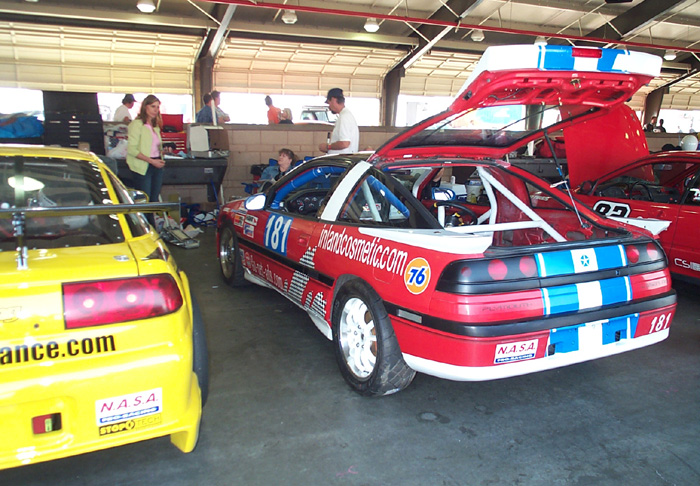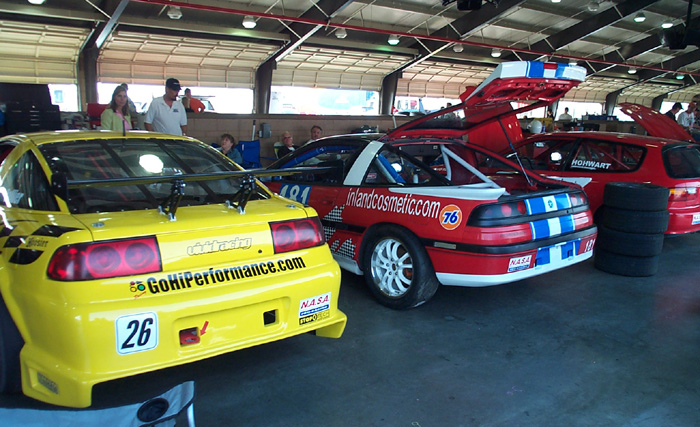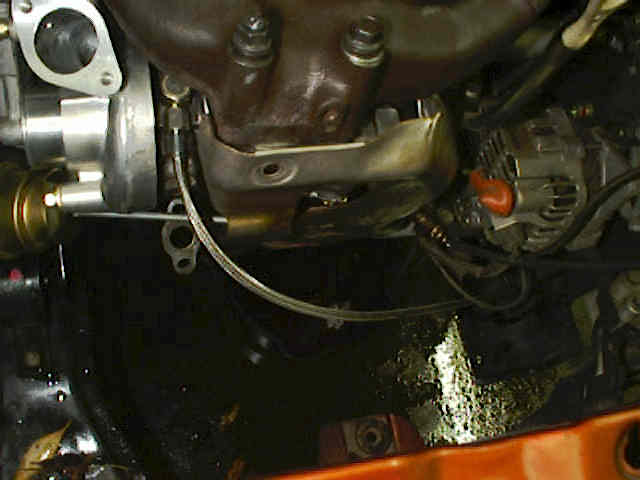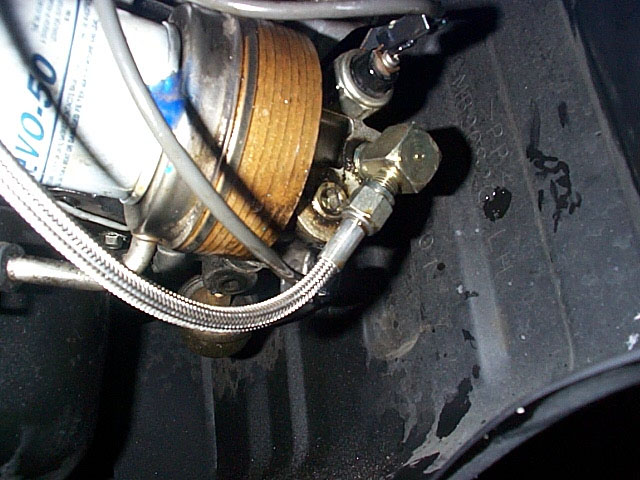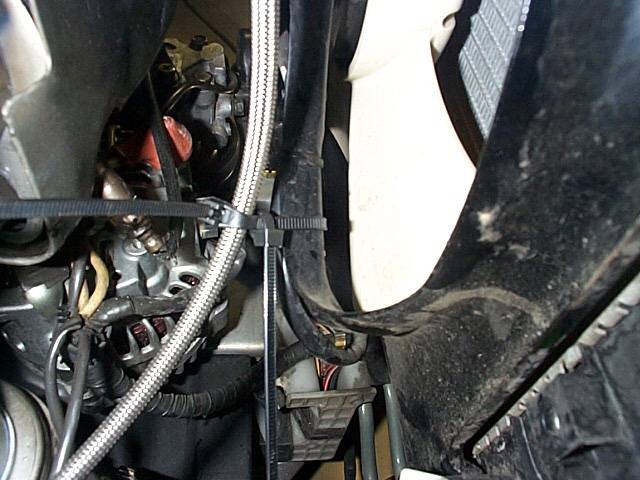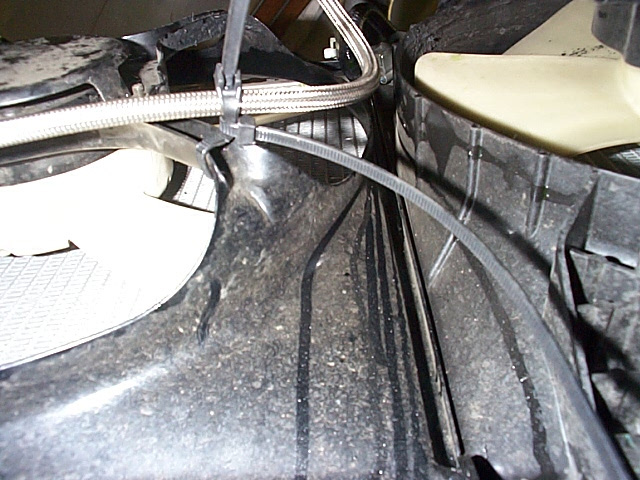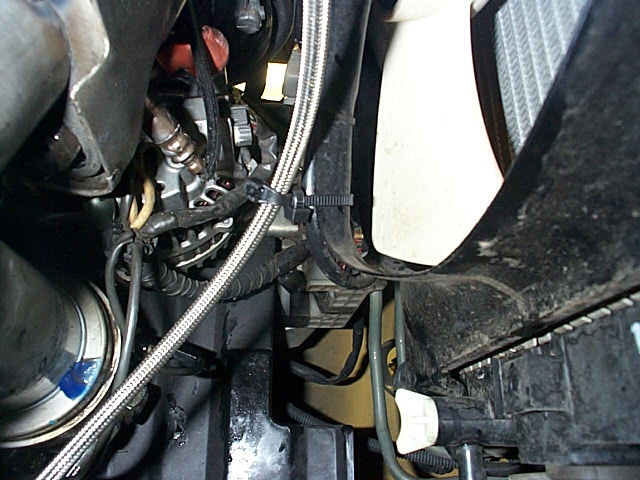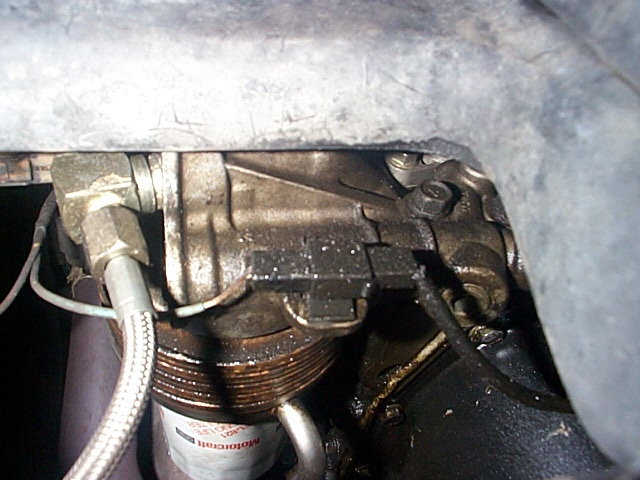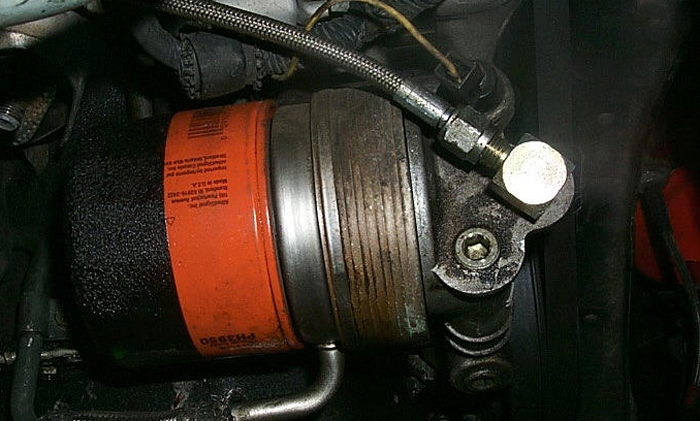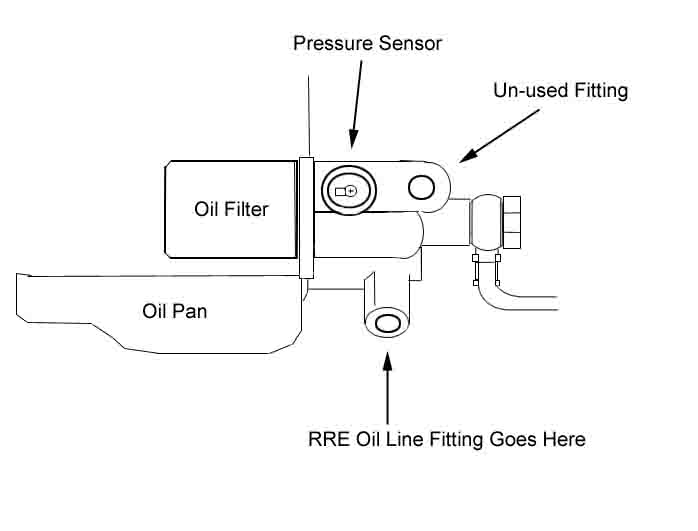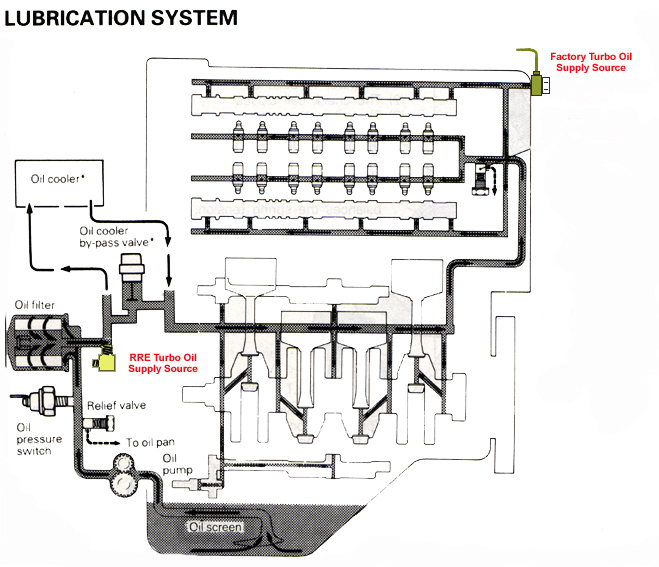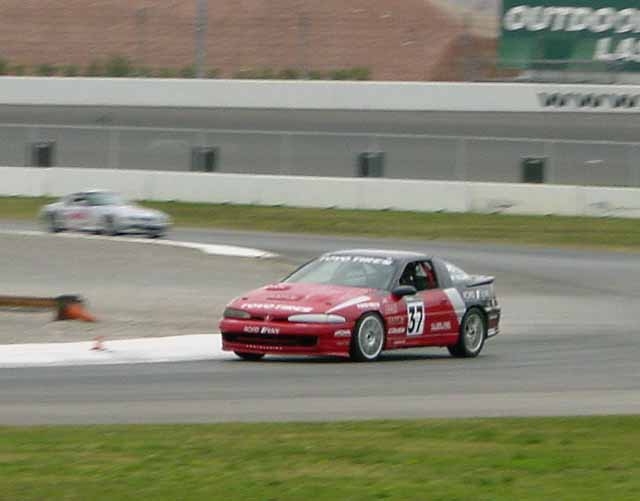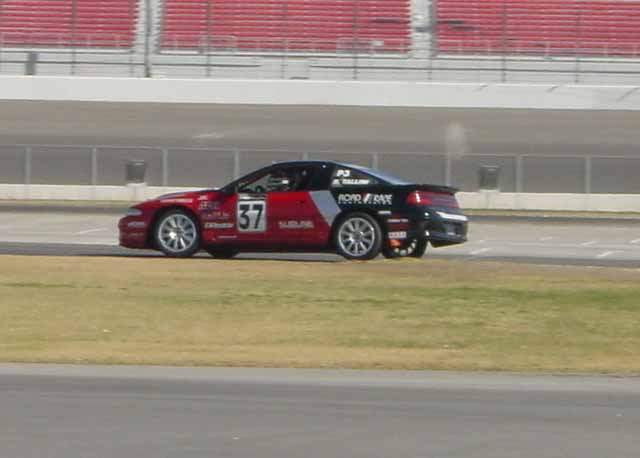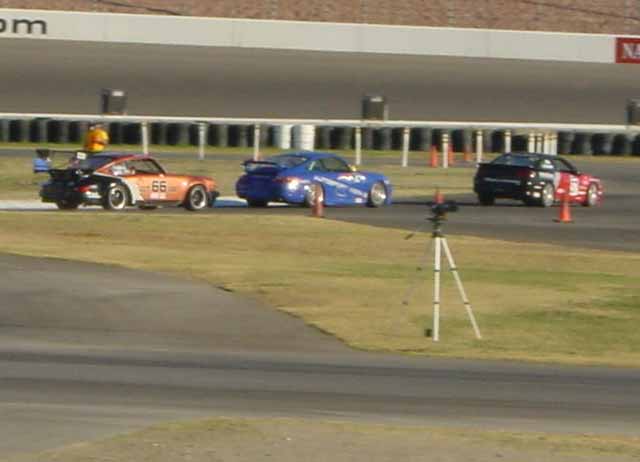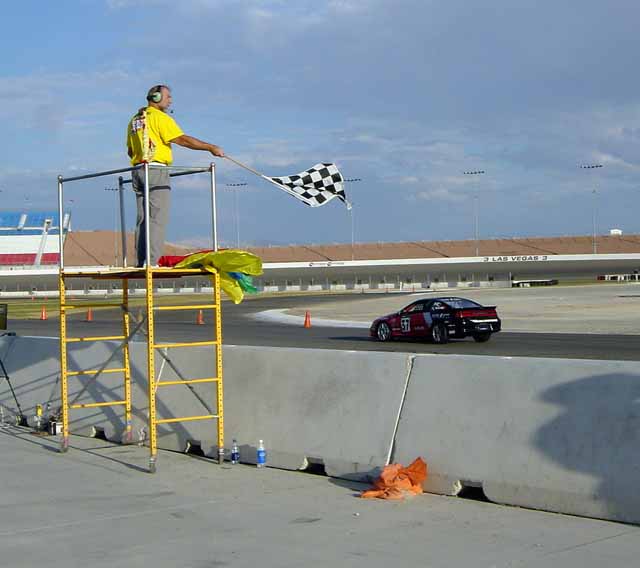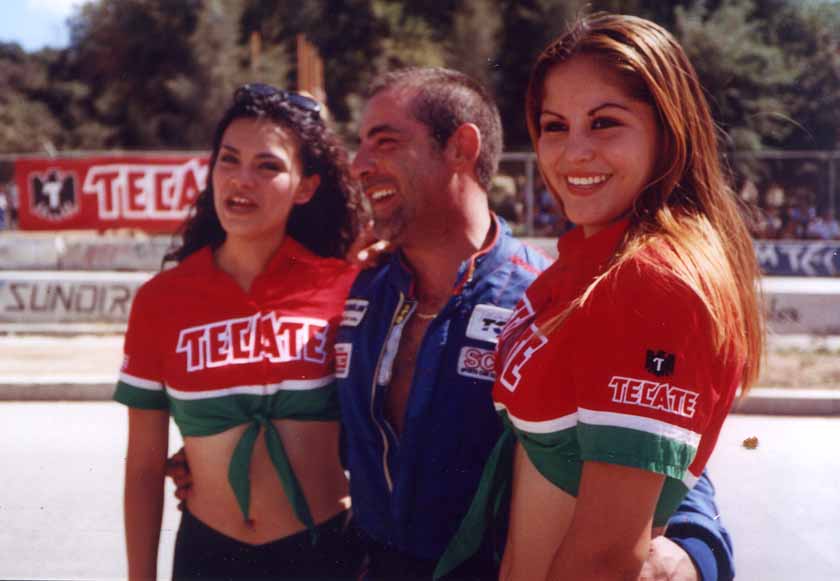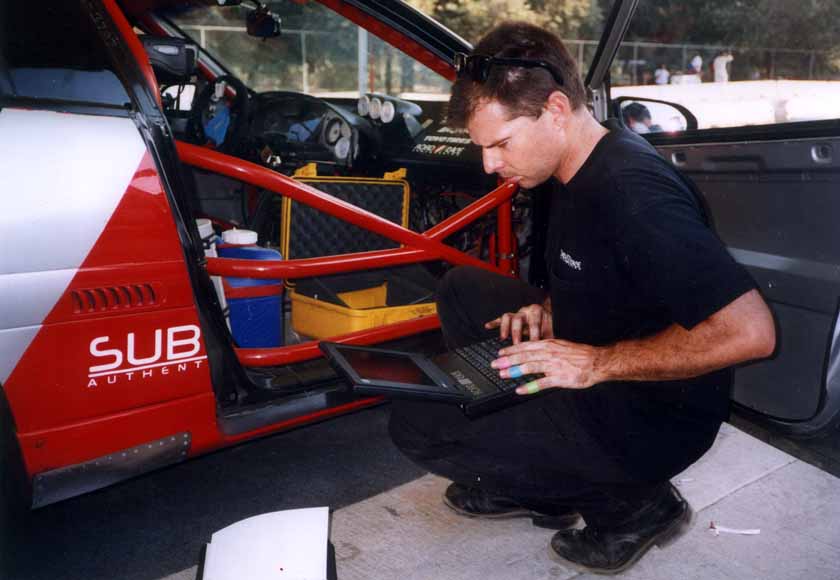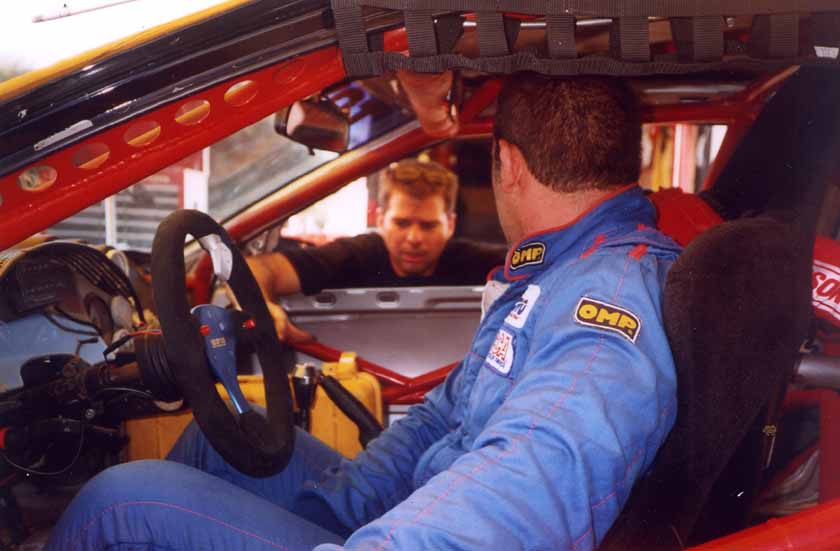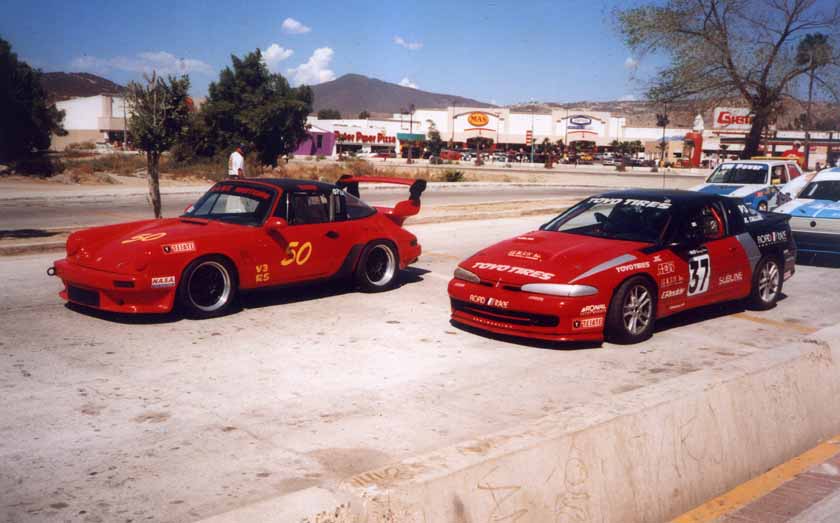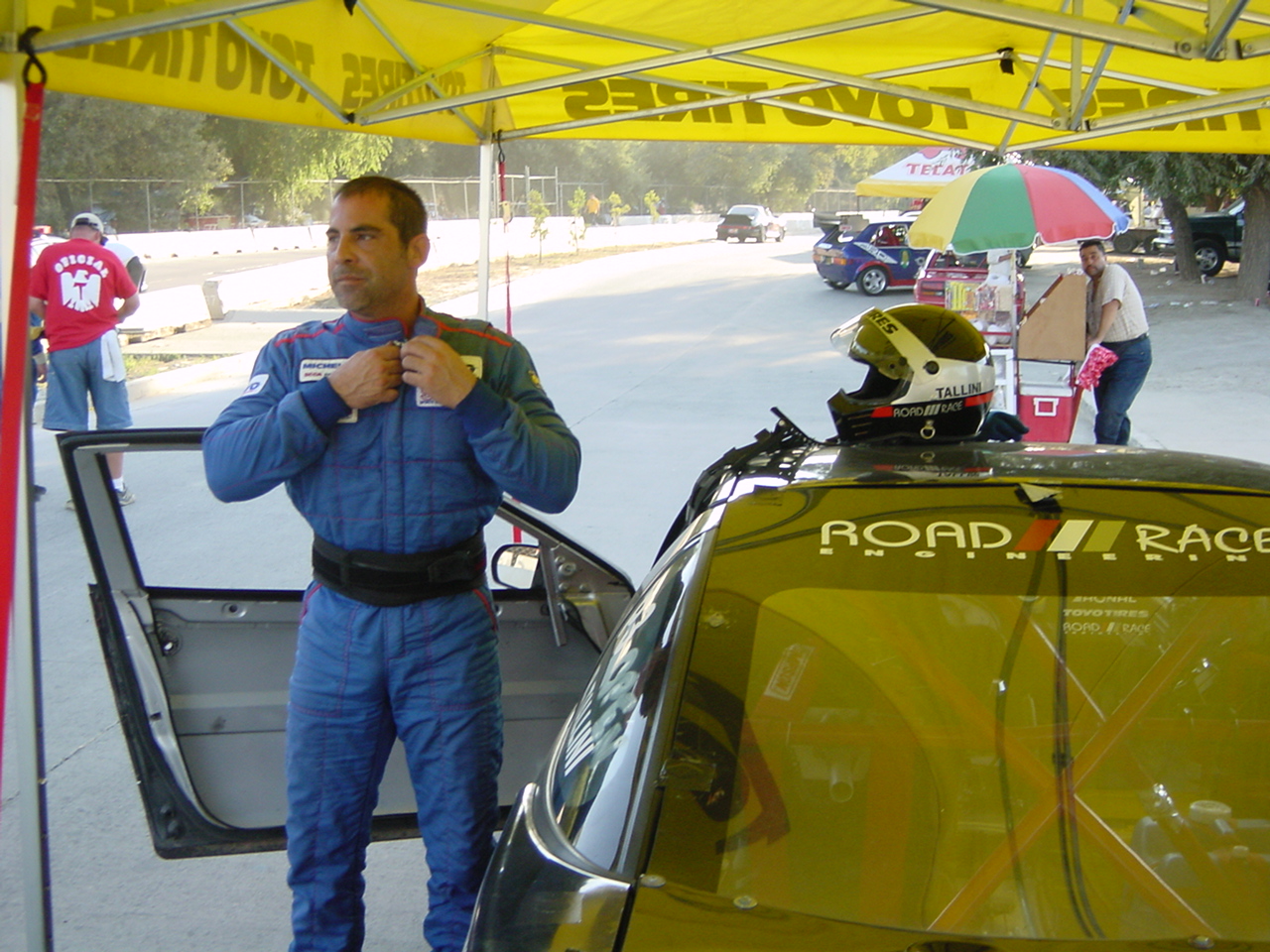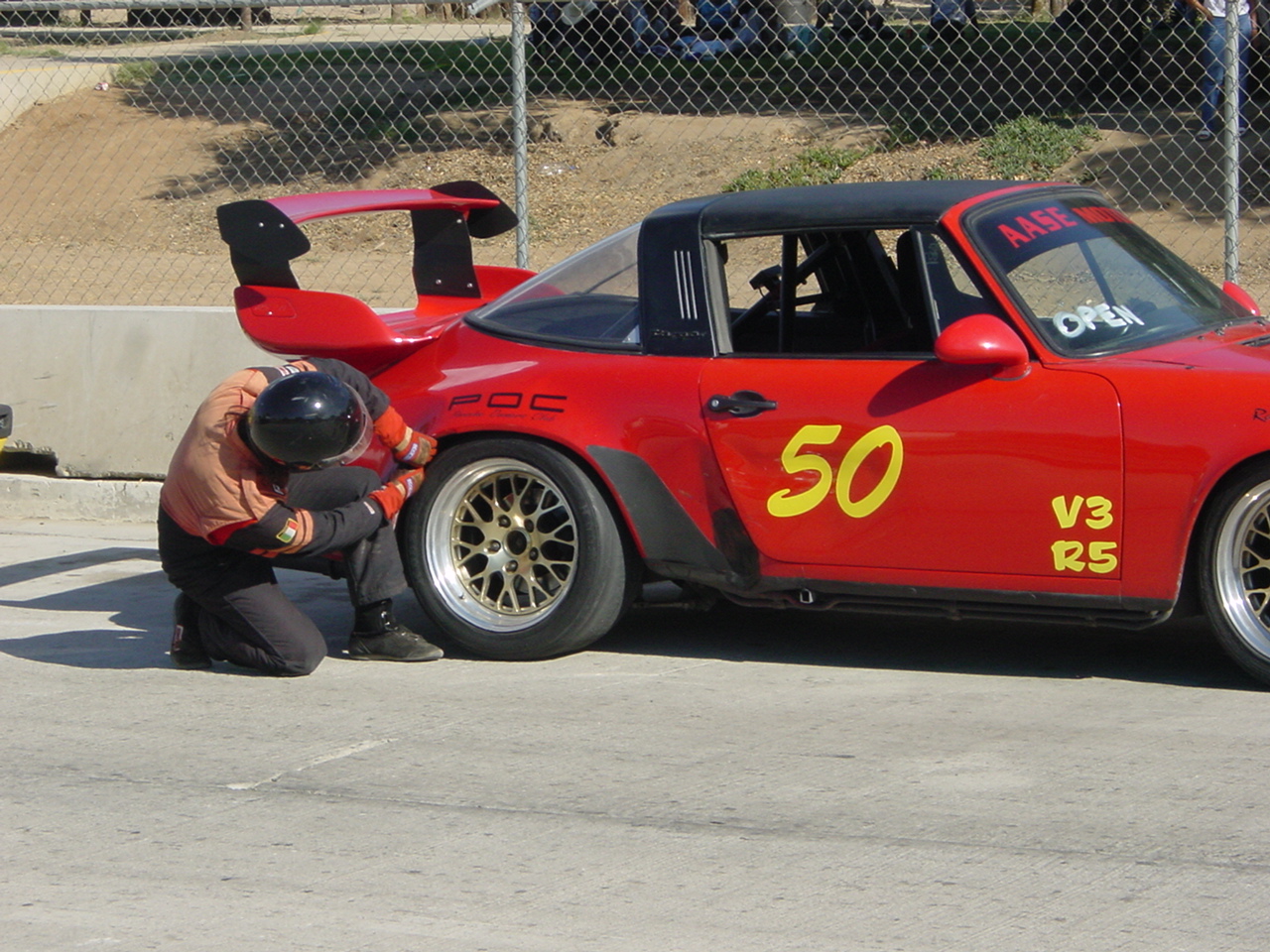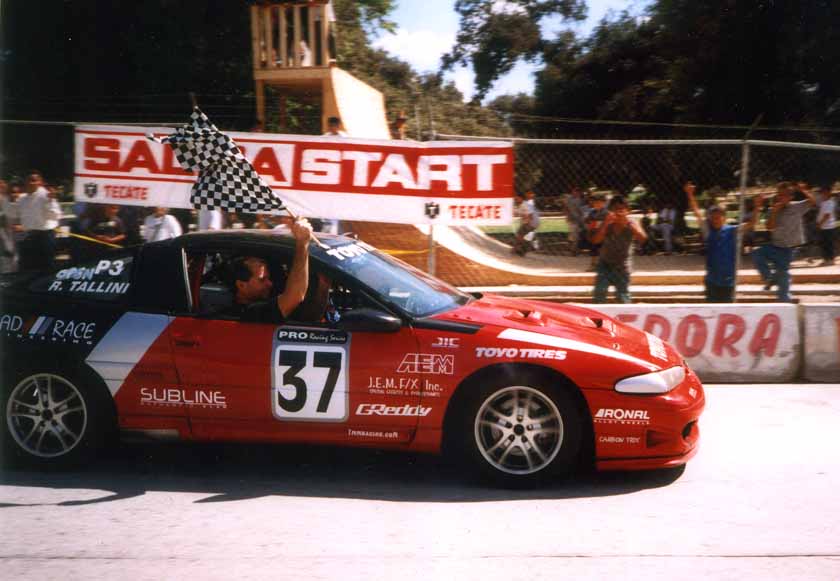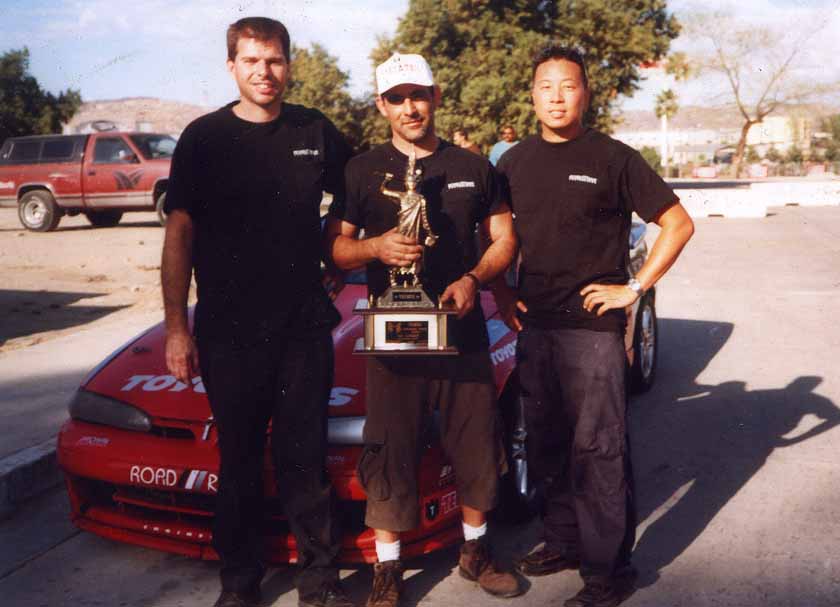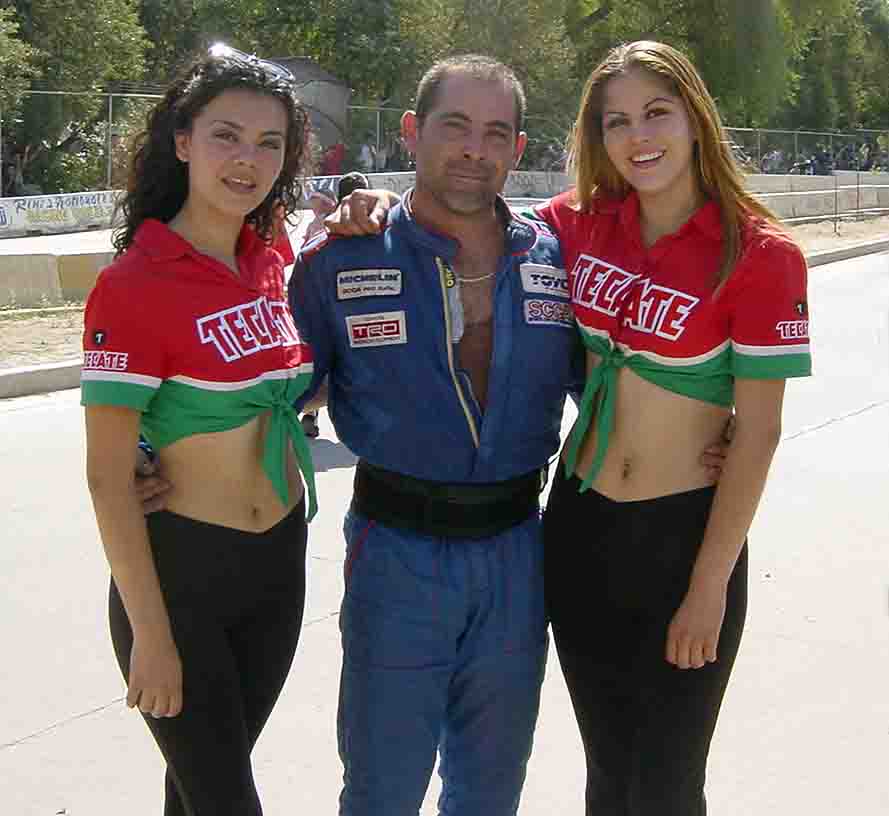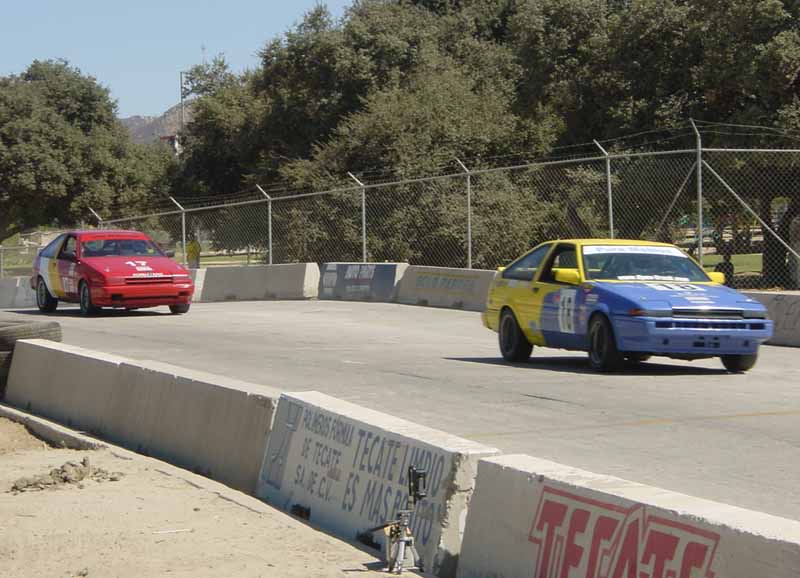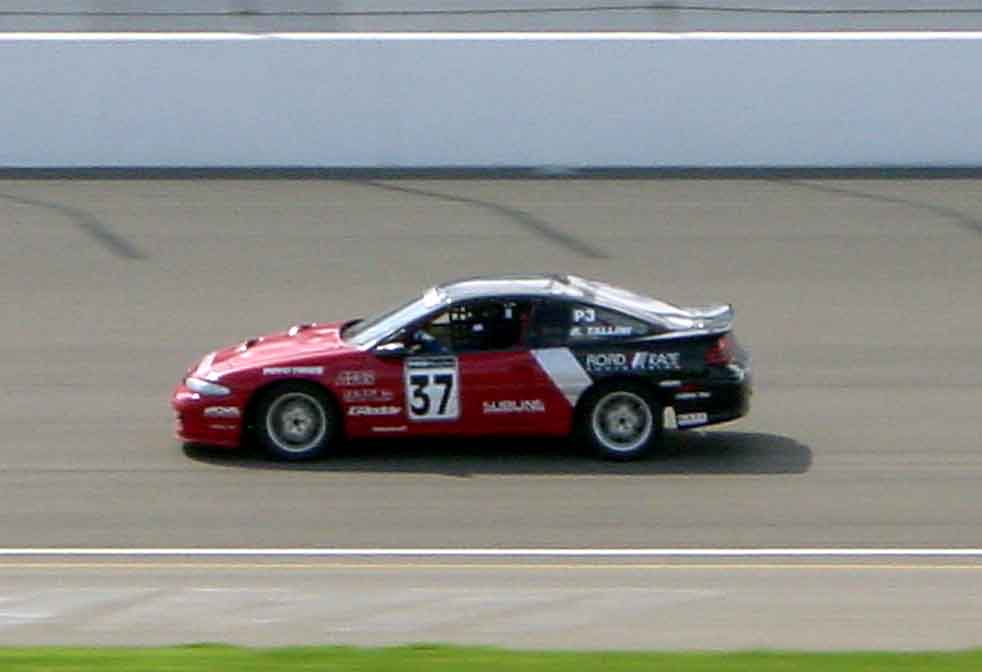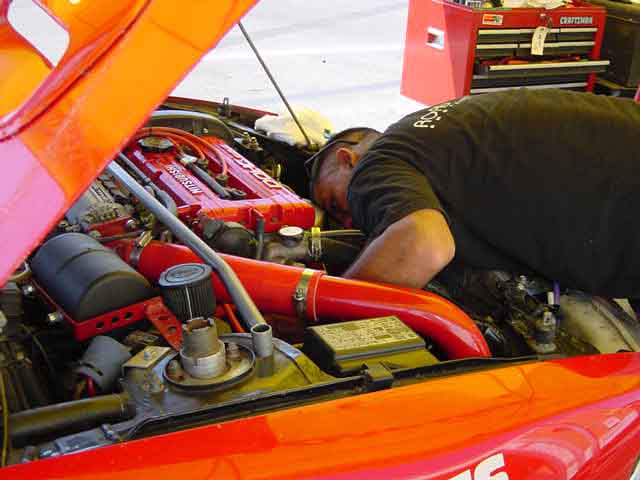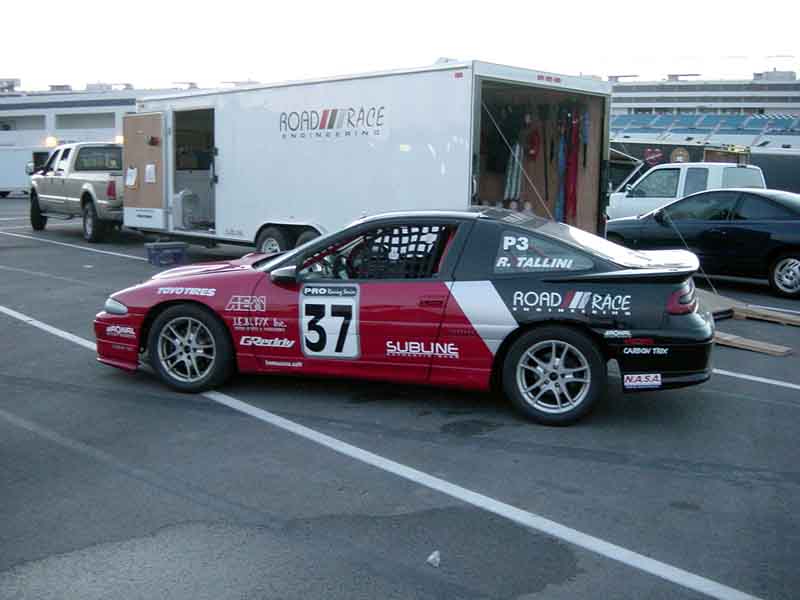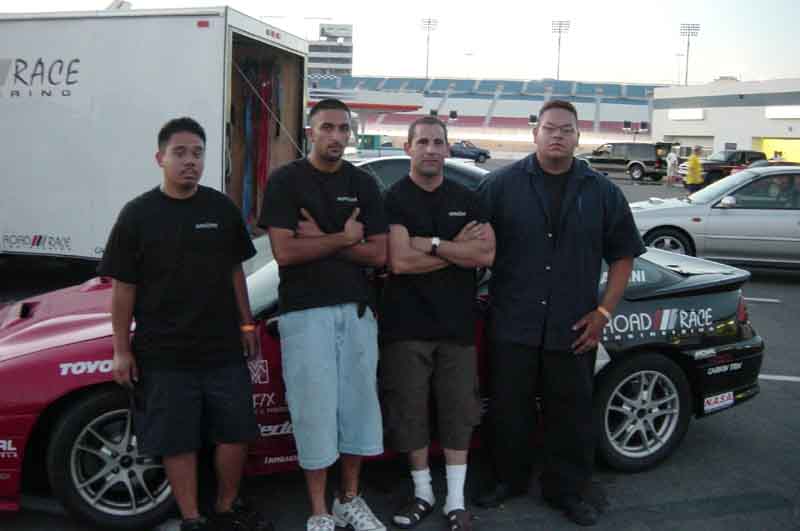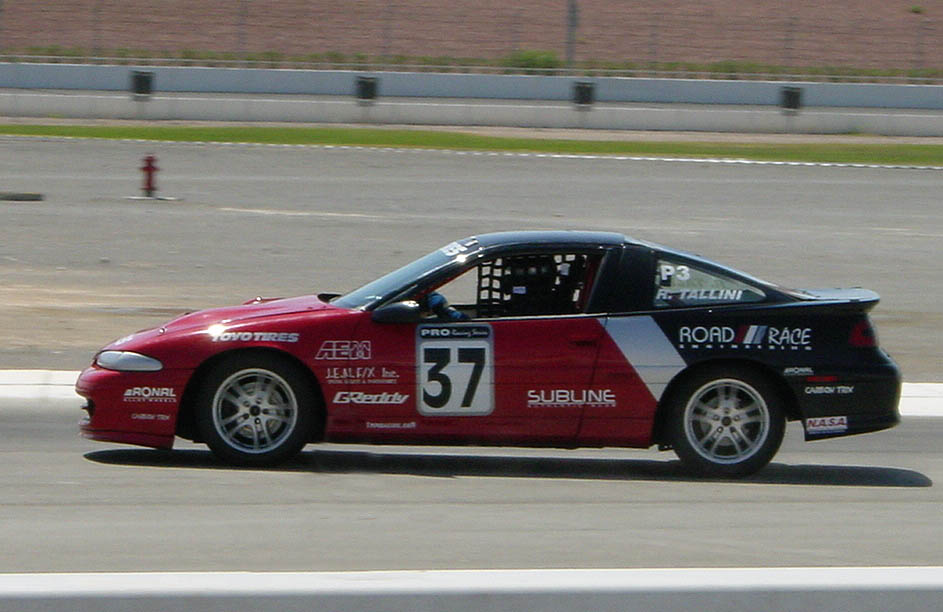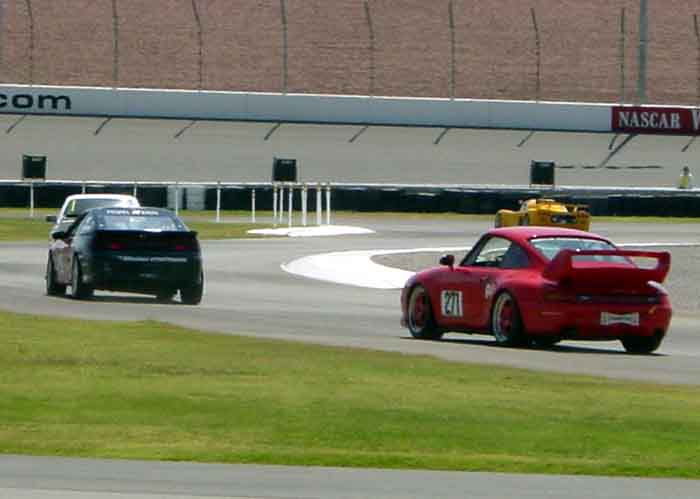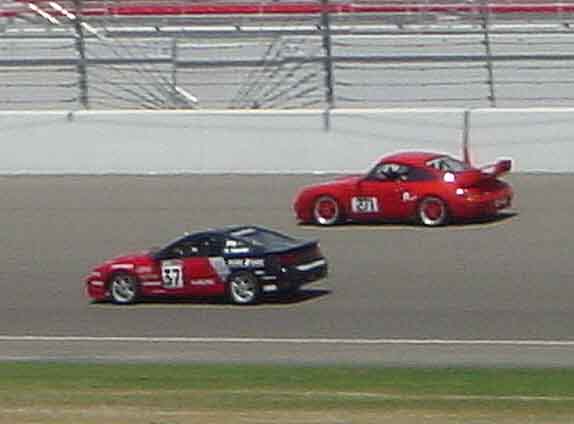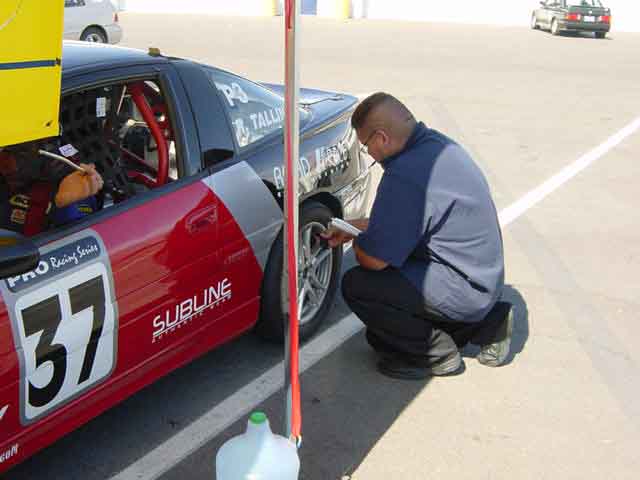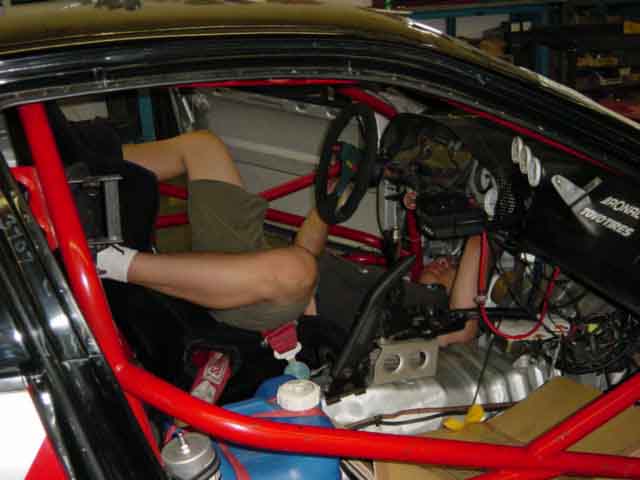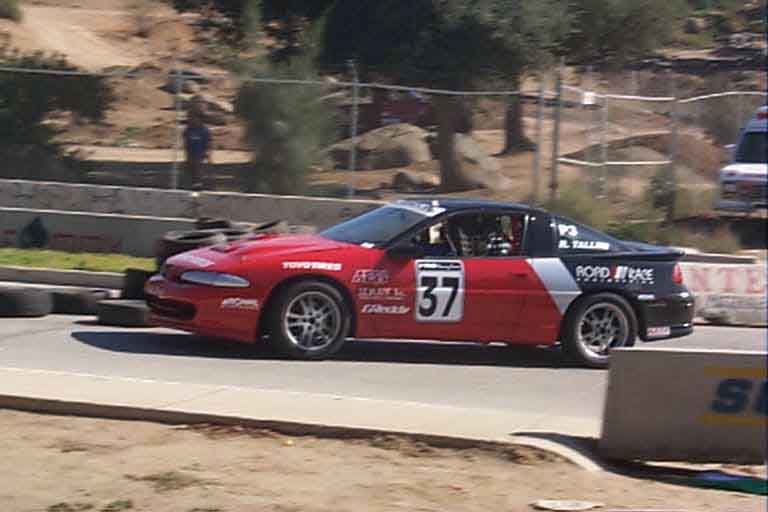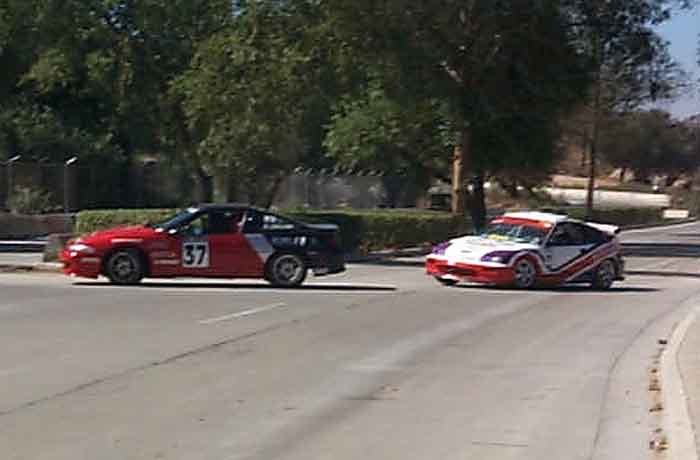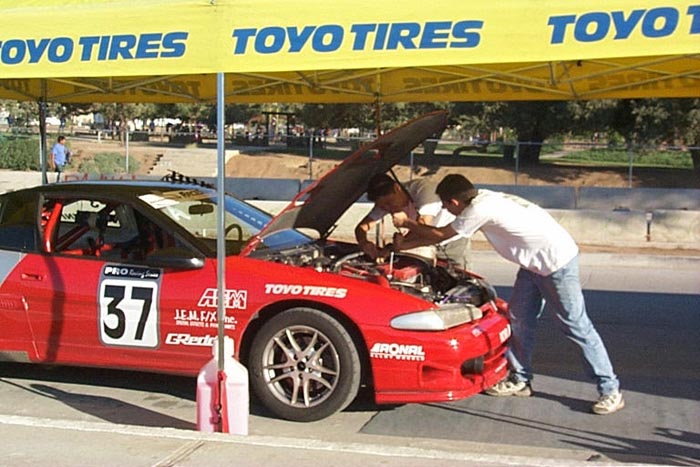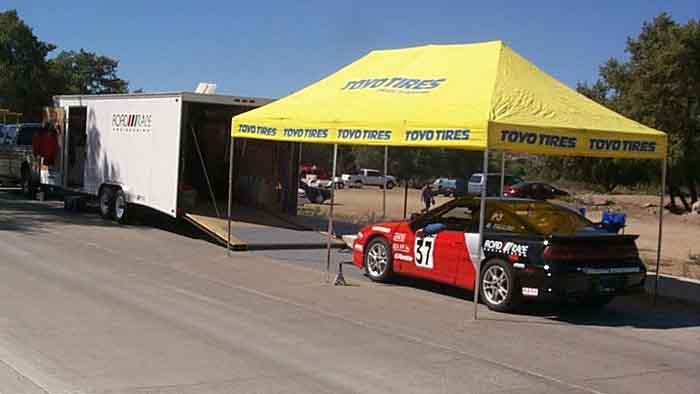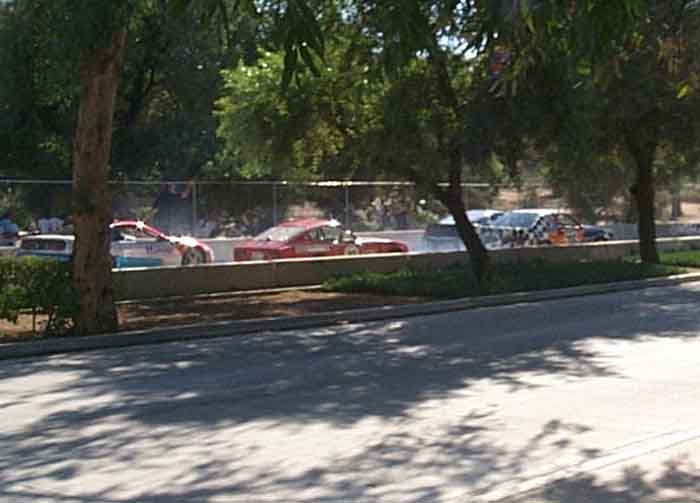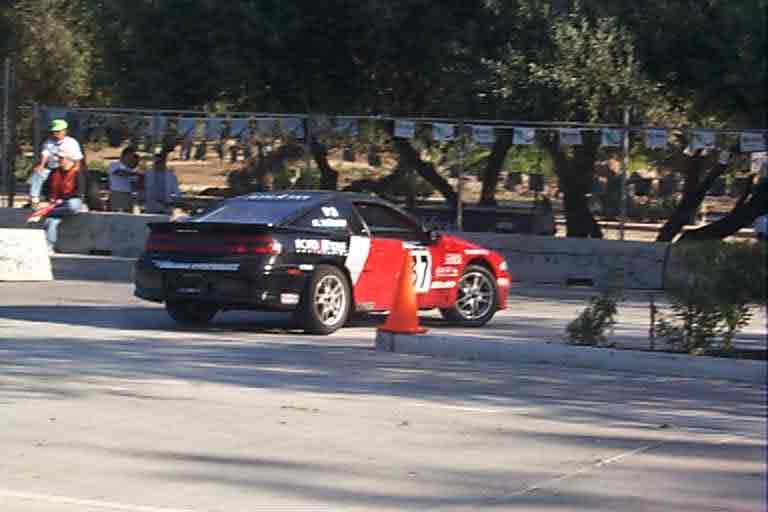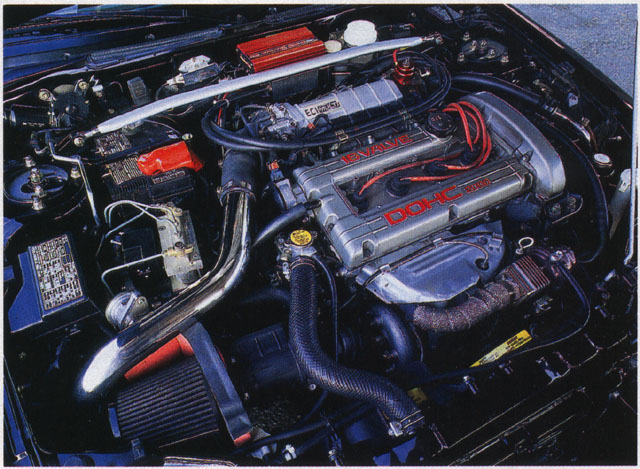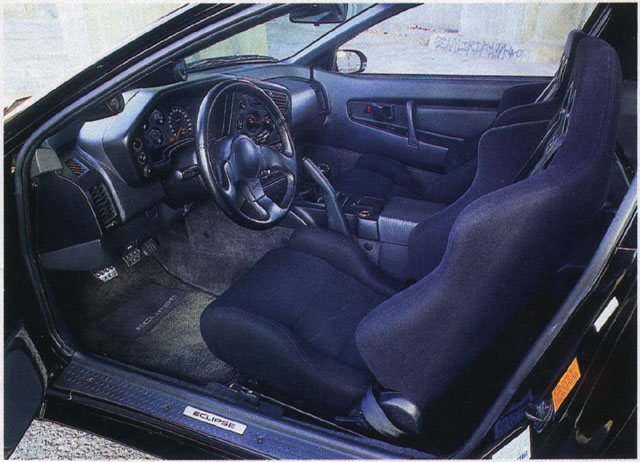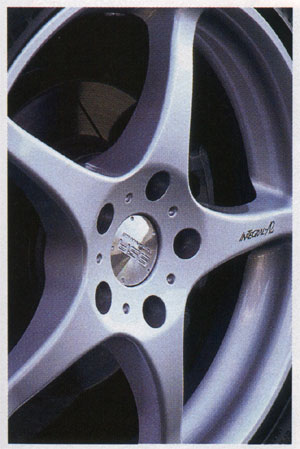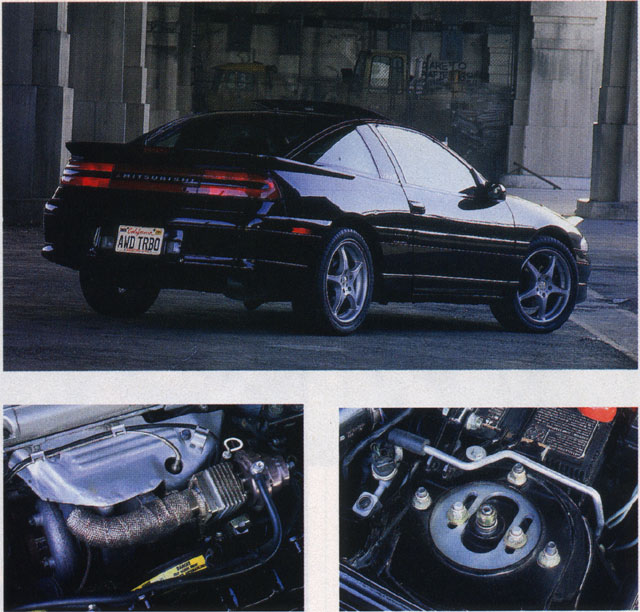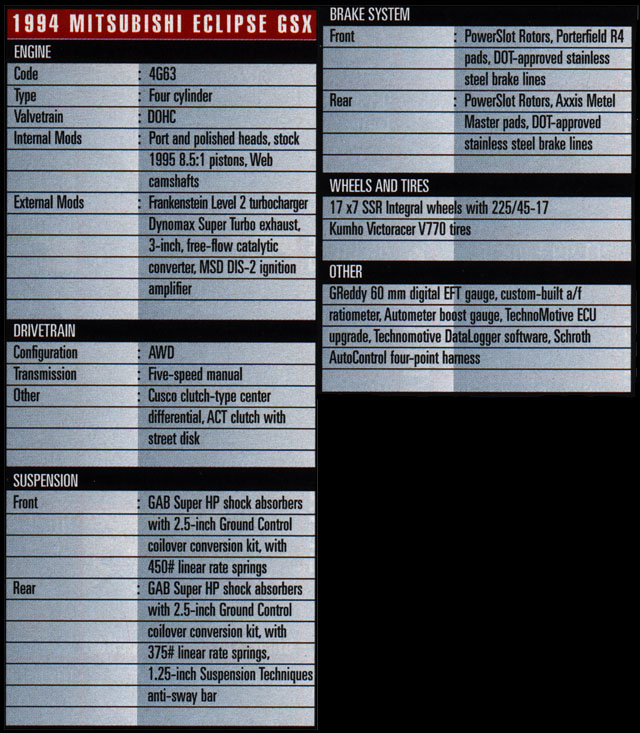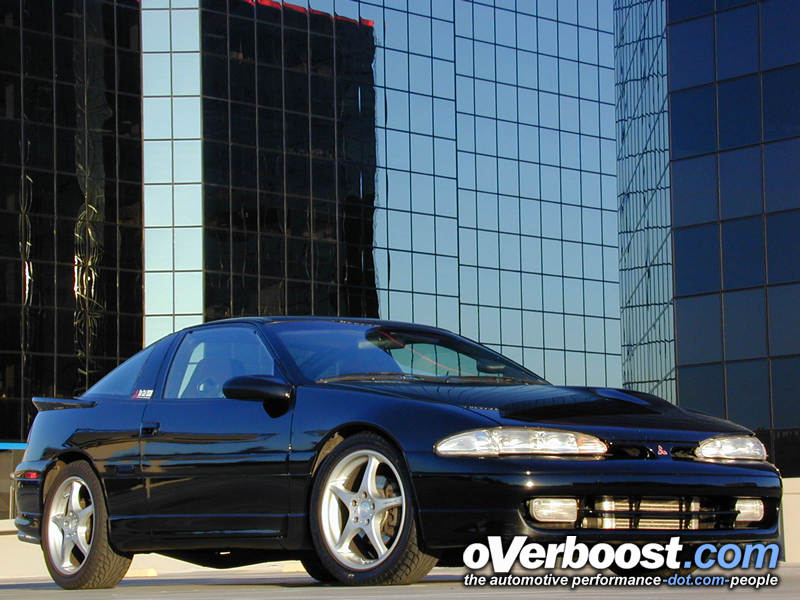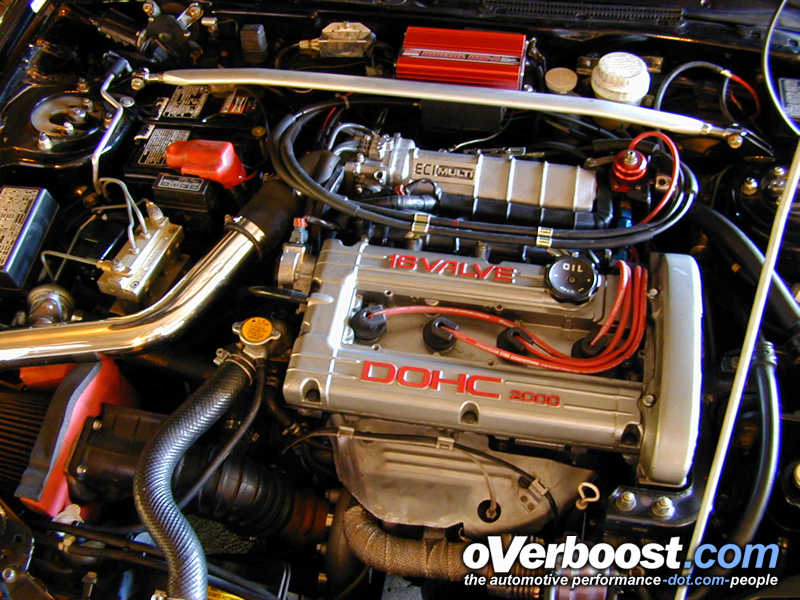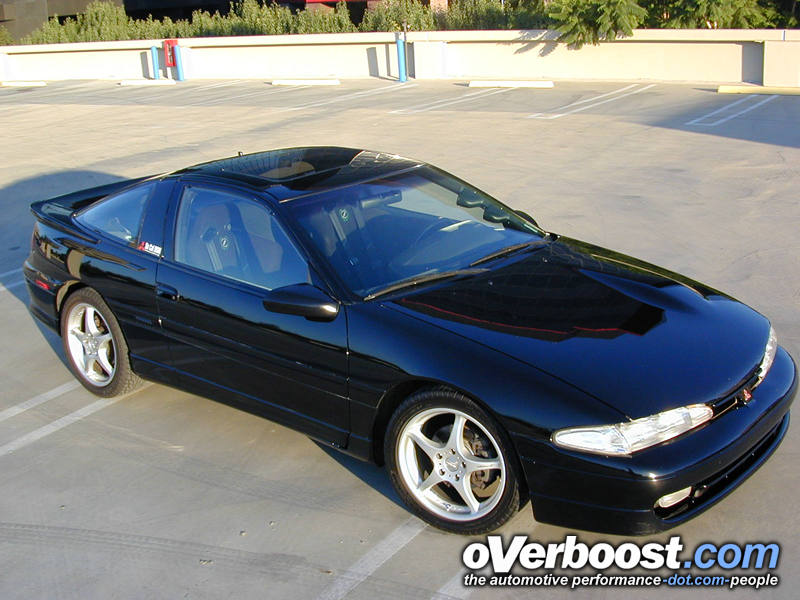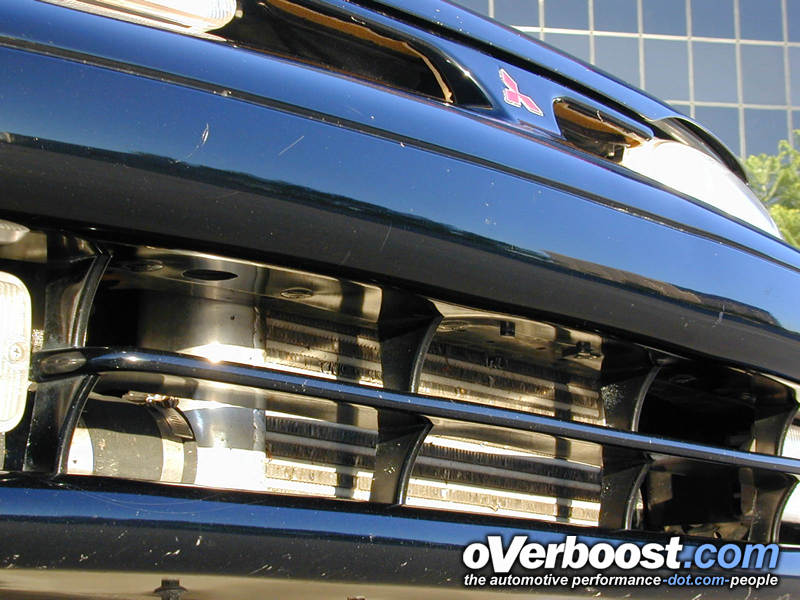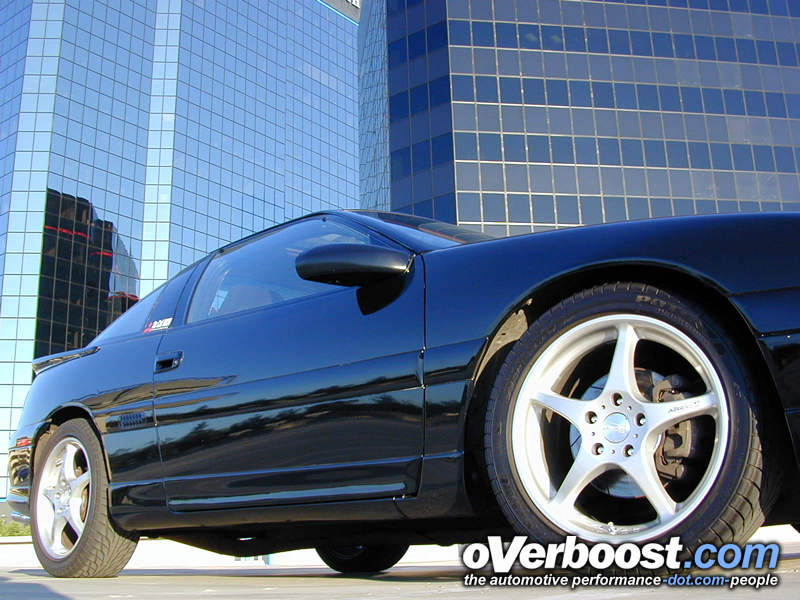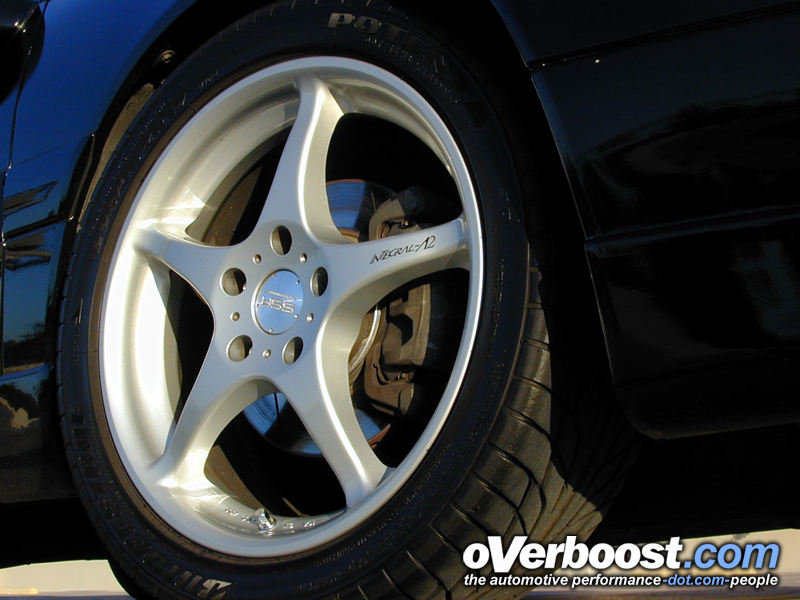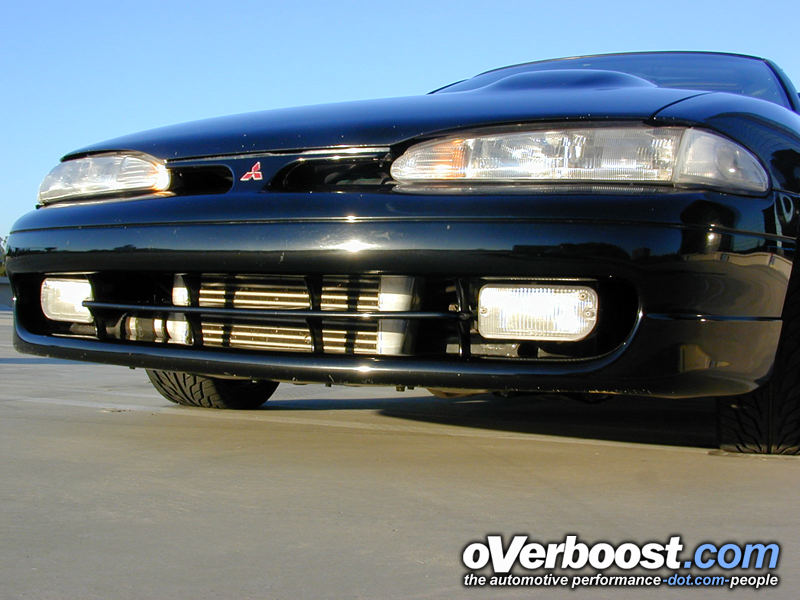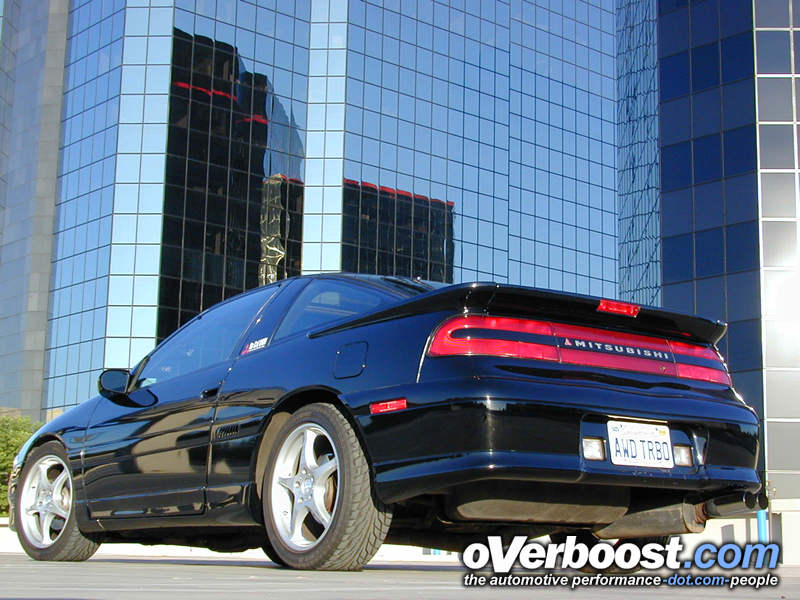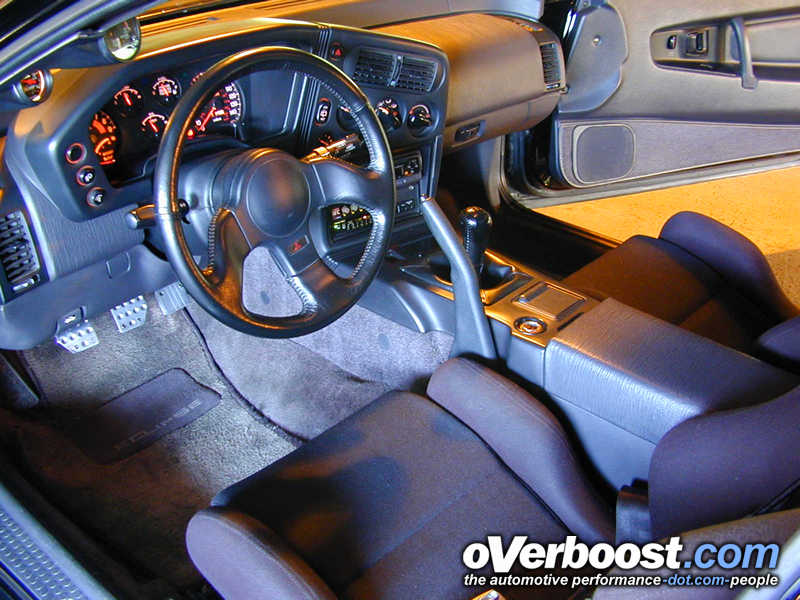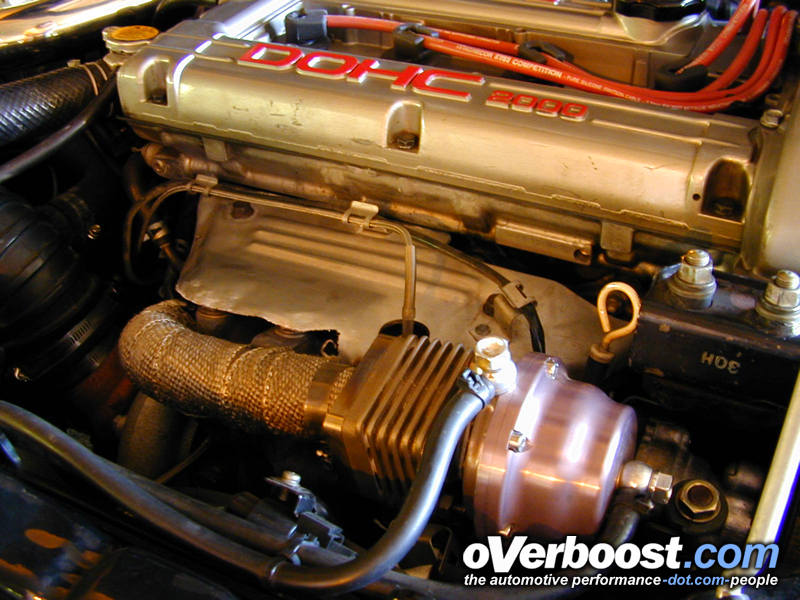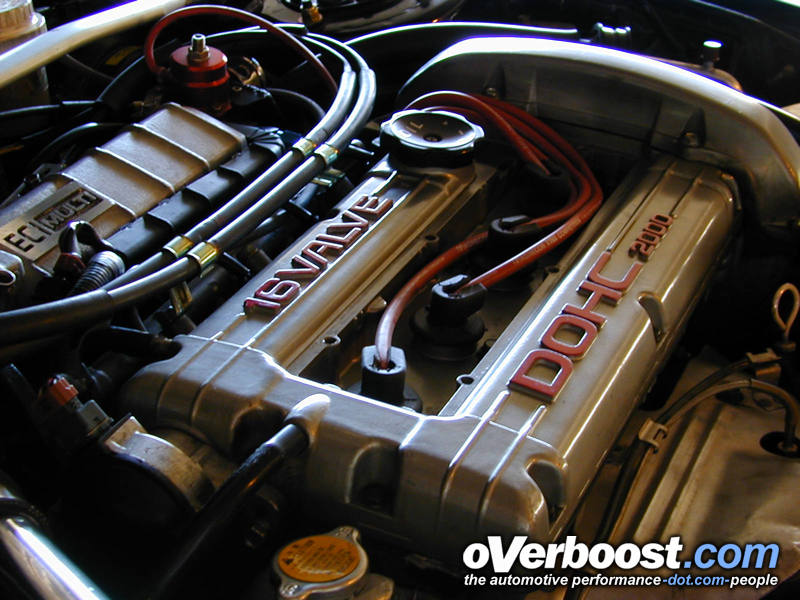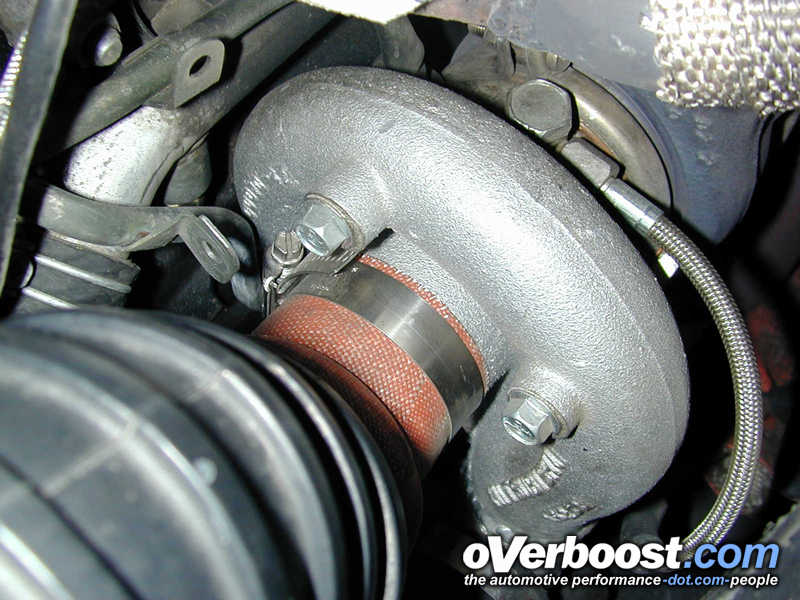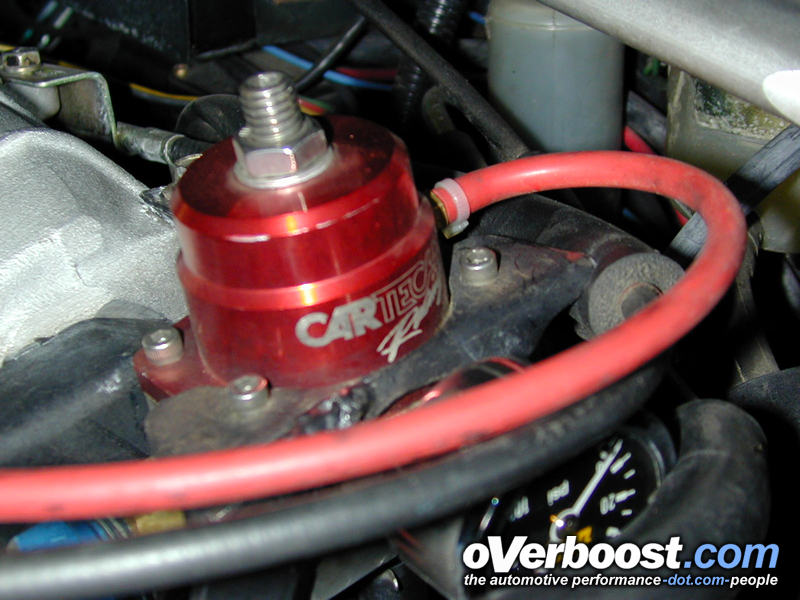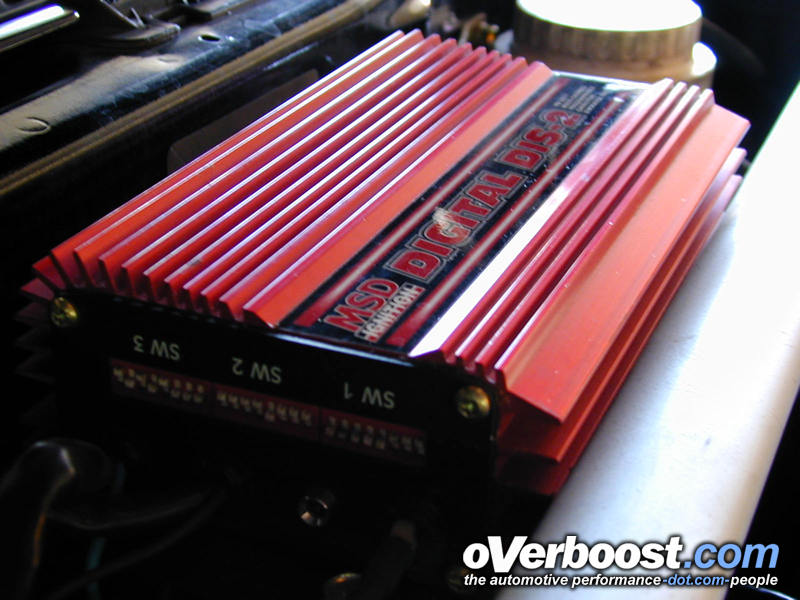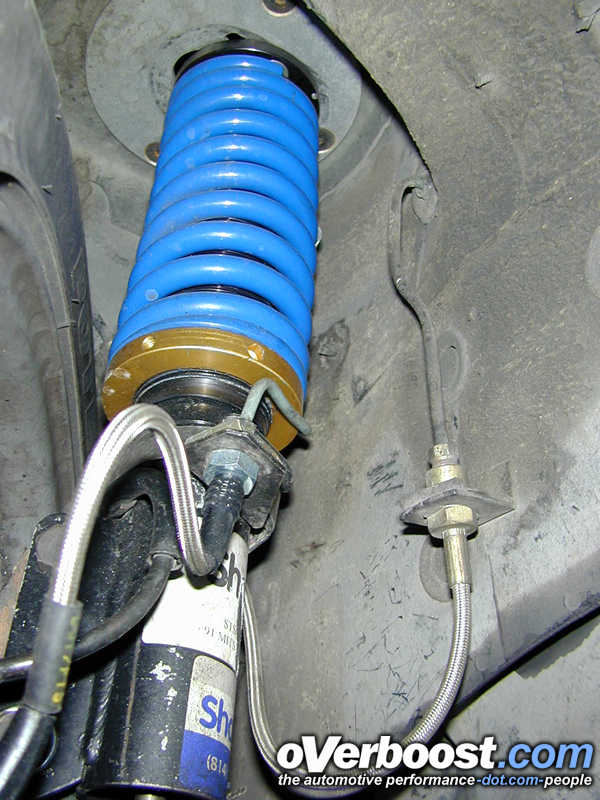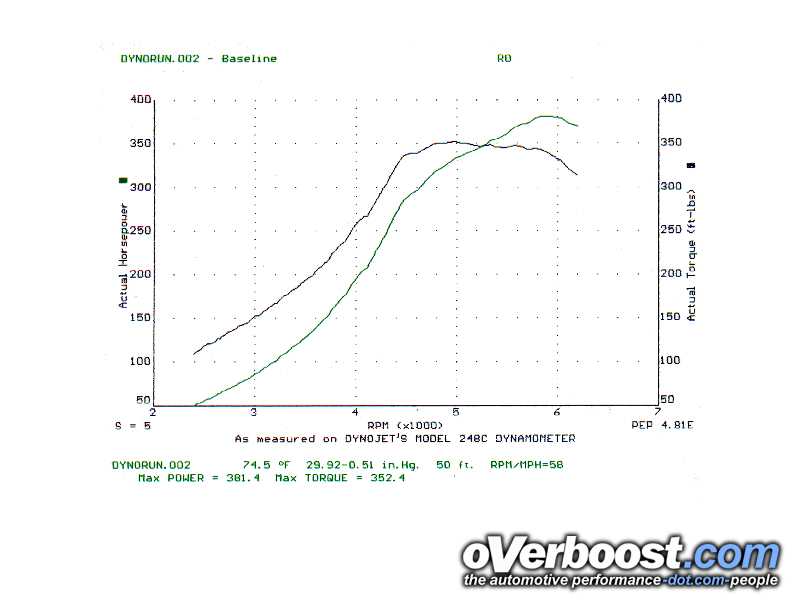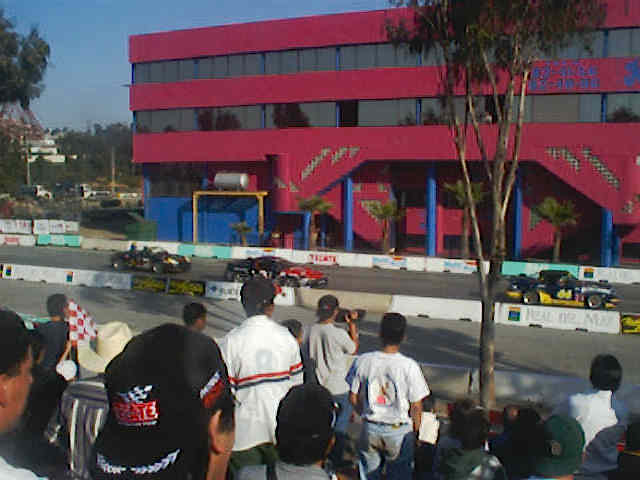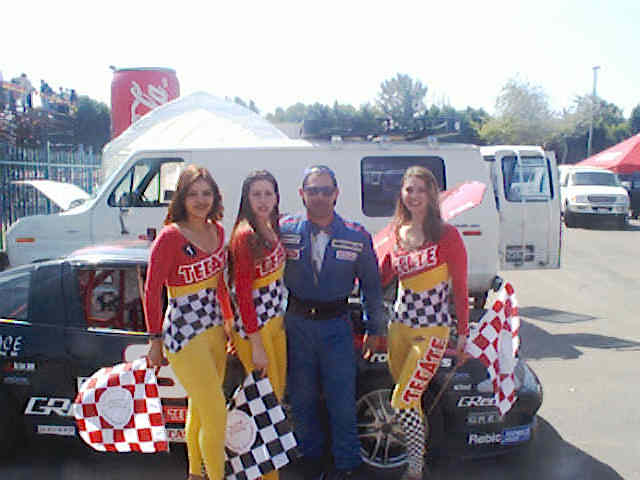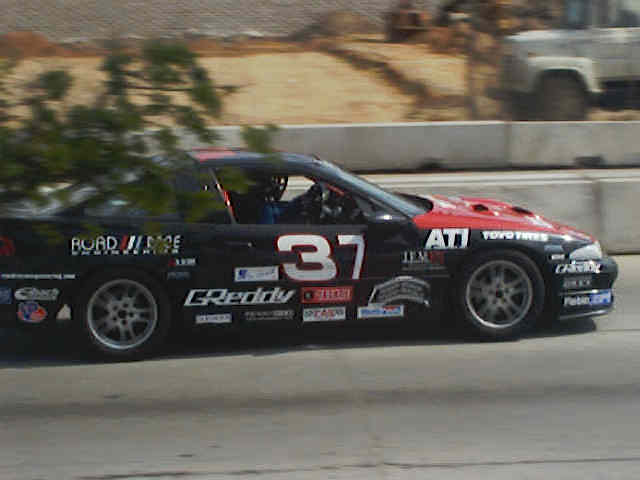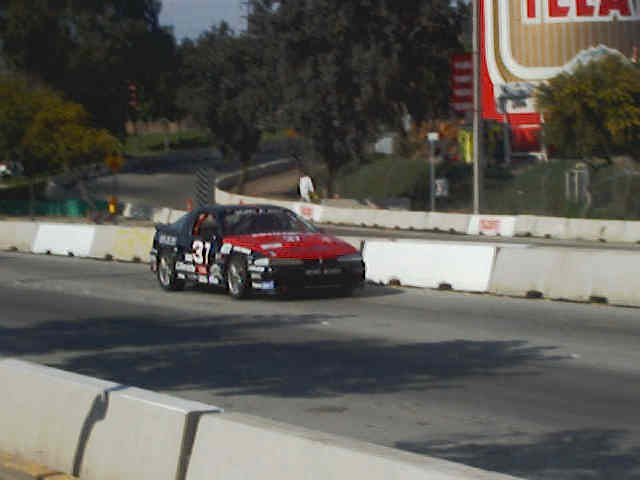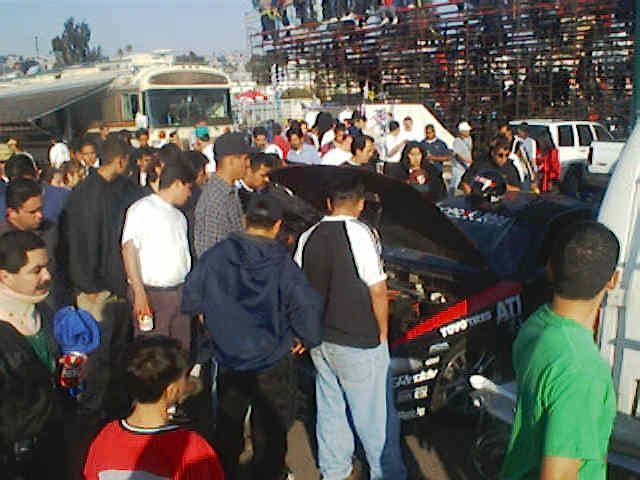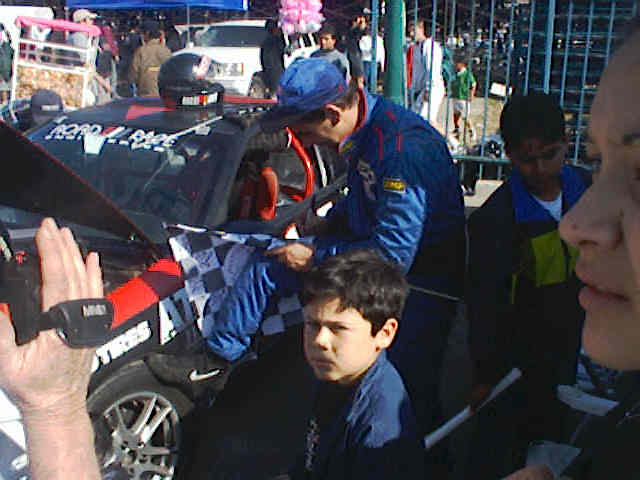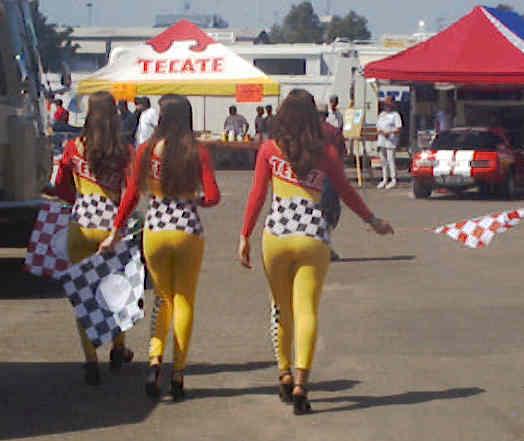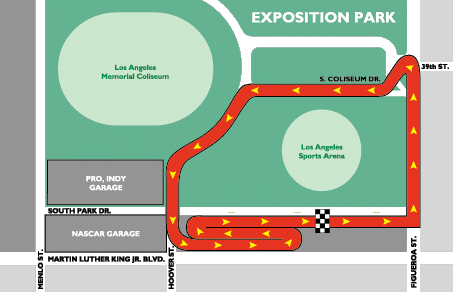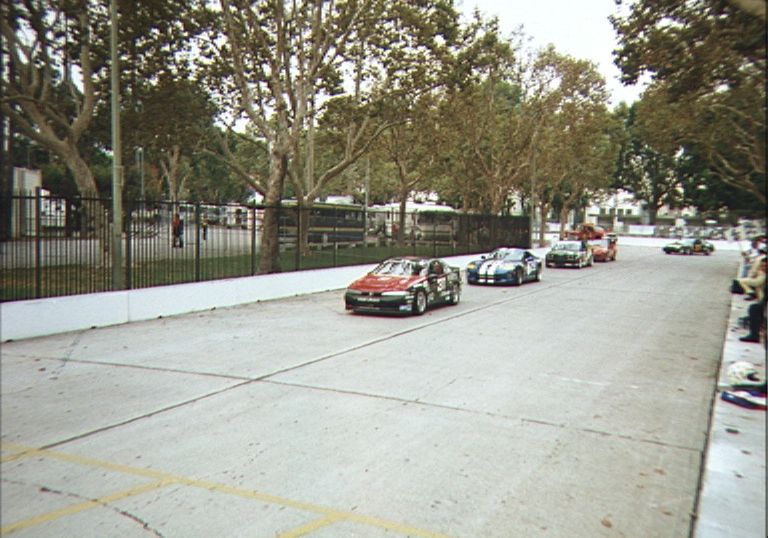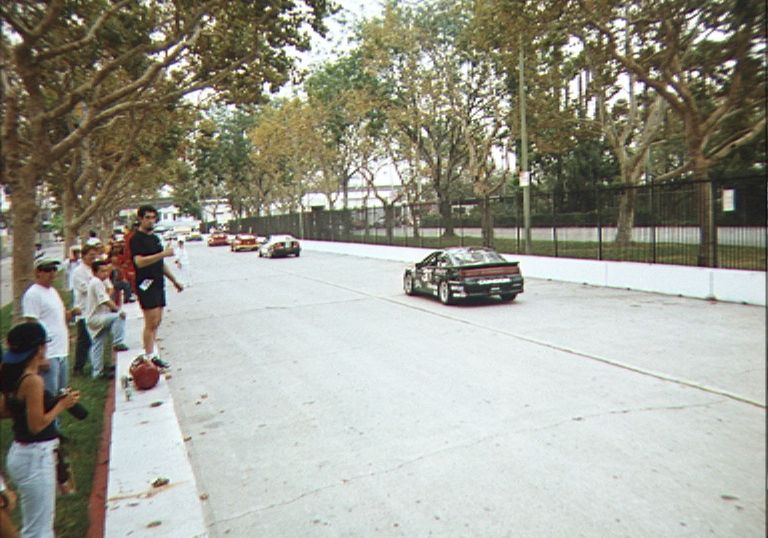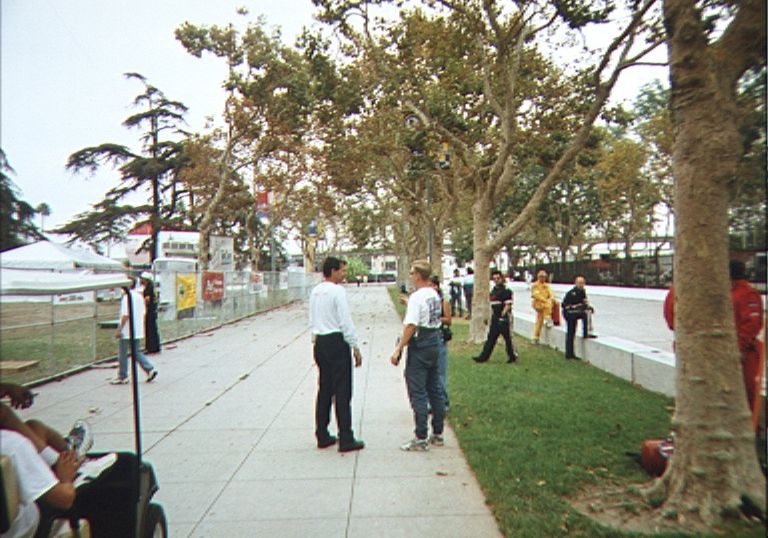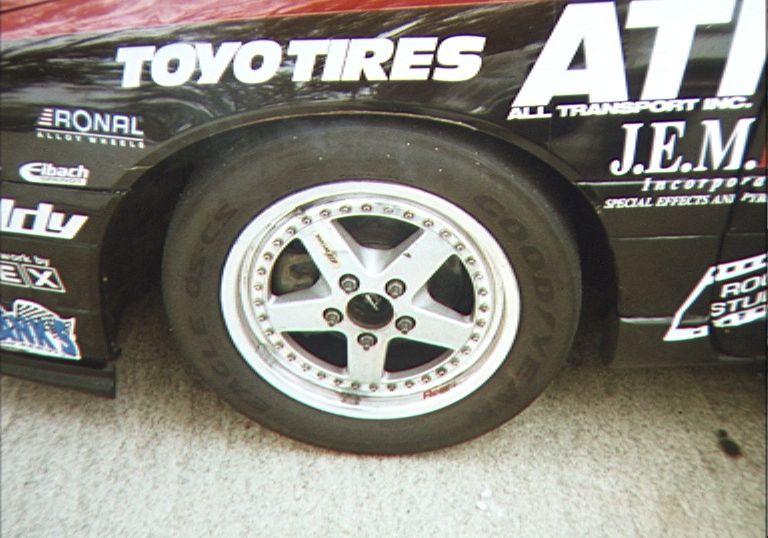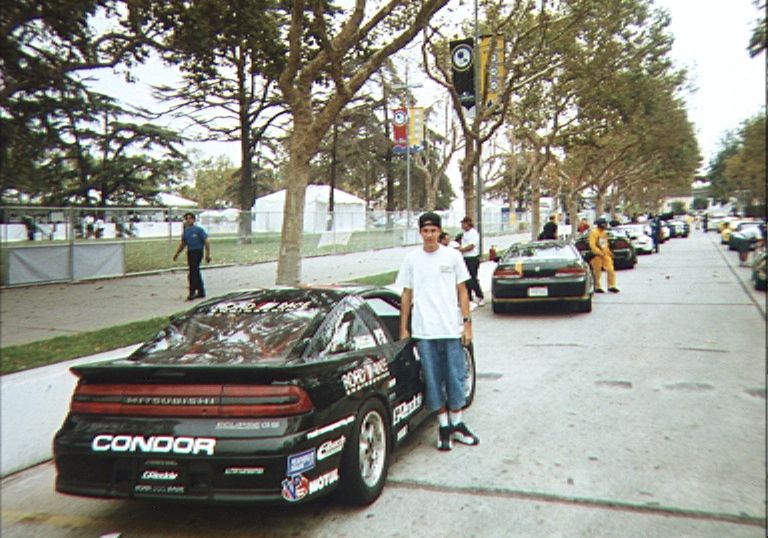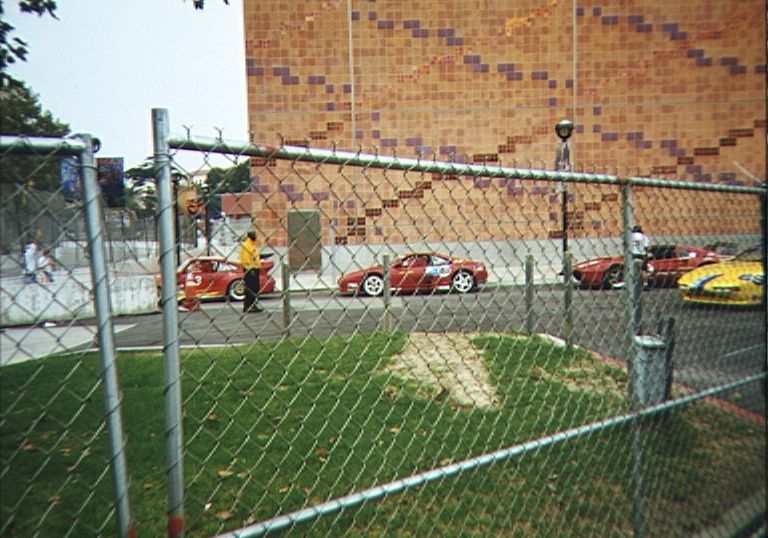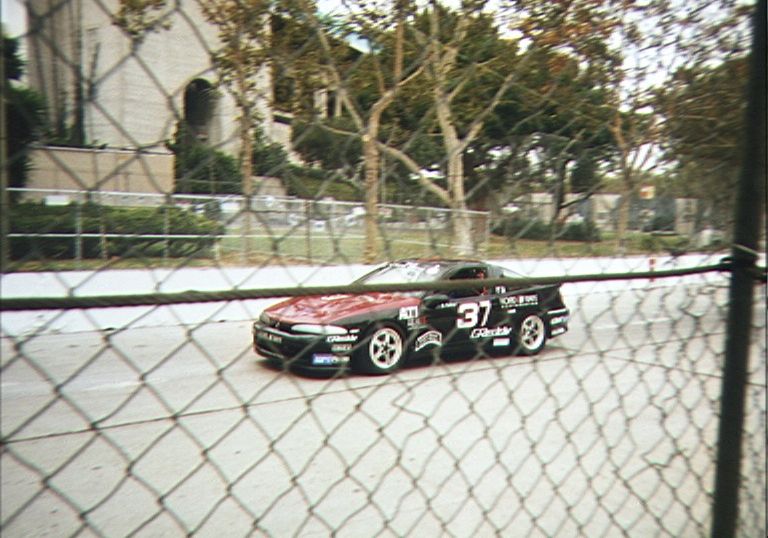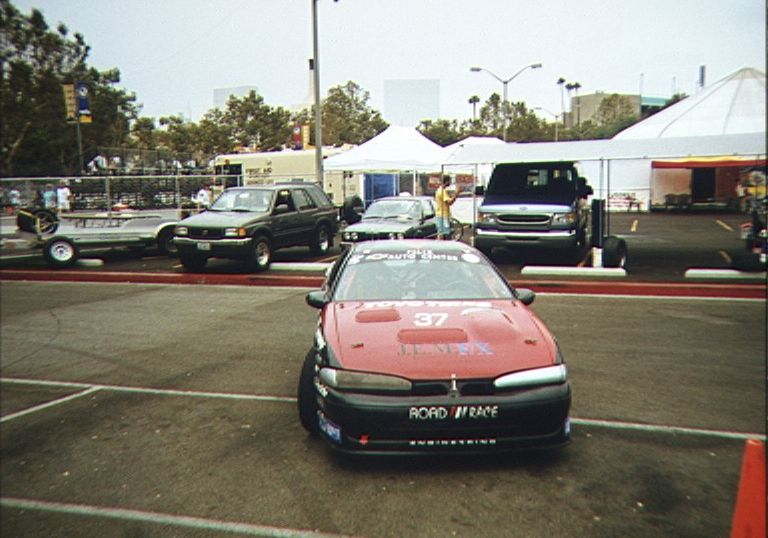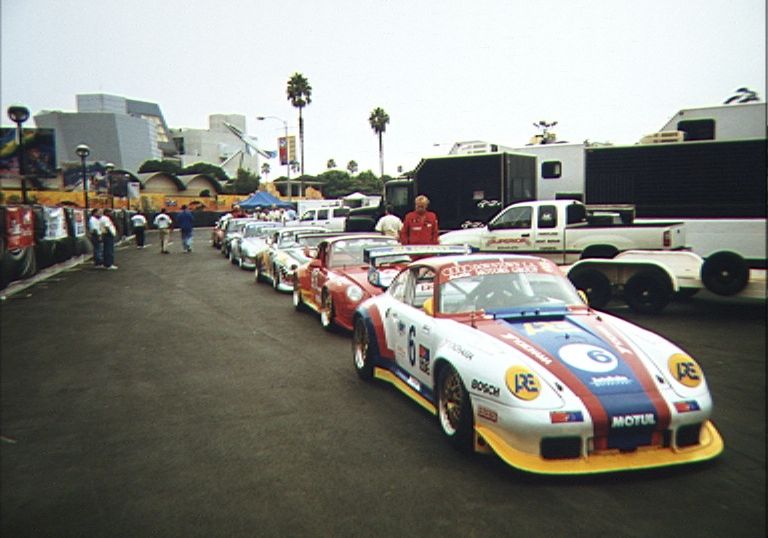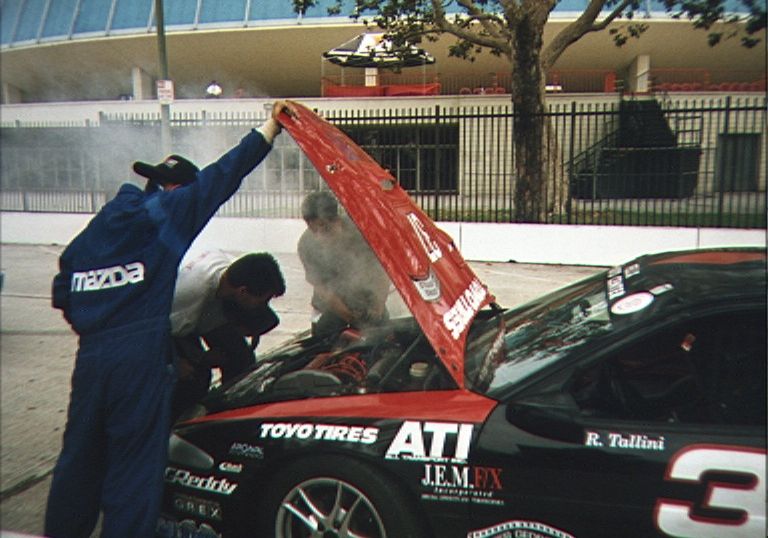Suffering From A Loss?
Matt Farah from The Smoking Tire put up this excellent PSA for those suffering from loss.
Yes that is Tony Bird’s 1G AWD!
1G GSX – E85 – Sam Dyno Tuning With DSM Link
Sam here at the shop tuning with DSM Link on Kris’ 1G GSX track car is running a used stock 6 bolt long block from a used 1G 140k mile auto DSM he picked up. FP 3065 (GT35R-ish sized) bolt on style turbo. The fuel pressure was dropping big time once the boost got up past 30 psi. With a Walbro 255 lph pump not keeping up, with the car still on the dyno we put in a Walbro 400 lph fuel pump, reset the base pressure and Sam went at it some more. That fixed the fuel pressure problem. There is a bit of surge on the spool up, nothing we could do about it. It is just there on a longer pull on the dyno.
DSM Revival
We still get quite a few DSMs through the shop. In addition to the ones that have always been running, we get some 1Gs that have been sitting somewhere for a long time but are still in decent shape otherwise. For one reason or another the owner decides it is time to get it dusted off, drag out all the parts that have been collecting over the years and finish that project. This is what you get when a car sits for 6 years :-P
We end up replacing the fuel pick up assy, the pump, filter and injectors. If you let it sit, safest is to at least keep the tank full I hear.
License Plate of the Week – Alter EVO
Chris Bertino’s 1990 GSX showing off his alternative to the EVO!
Ask for a license plate frame with any order. It’s free! You just need to ask for it. Got a pic of your personalized license plate with an RRE plate frame on it? Send it to us and we’ll put it here.
Willow Springs Track Night
Here is a cool video of Scot Grey out in his dope 1G at STREETS of Willow Springs braving the hot hot summer heat with some night action!! Scot can normally be found driving cars on the dyno as RRE’s tuner.
Our good friend and both customer and supplier Ziggy from Zeitronix also took his 1G GSX out for some night runs.
Greg Collier – 1G Eclipse GS-T – March 12-13, Race Report
By Greg Collier – Diary of first NASA race of the season at California Speedway.
NASA Pro-Racing Season Opener At California Speedway March 12-13
It was a sunny 80 degree southern California day when arrived at the track on Friday morning. We got situated in our garage space and got ready for our annual tech and then do some track testing. This being the beginning of the race season an annual safety inspection of the car is necessary. Technical inspectors check the roll cage configuration, tube thickness and approved padding, dates of fire extinguisher and or fire system, SFI approved drivers suit, shoes, socks, gloves, all in case you have a car fire, 6-point seat belts and window net which have to be replaced every 2 years since Dale Earnhardt’s accident. Then they start on the vehicle inspection checking wheels/tires, steering/suspension, and engine for fluid leaks, no anti freeze, overflow containers, battery secured, so-on and so-forth. You’ve got two or three guys checking every nut and bolt for about 15 minutes. You get your race log-book signed and you’re ready for the season. At any time in the following races of the season they can do a surprise inspection to make sure you didn’t change anything. If they find something you’ll get fined $ and until you pay the fine and fix the problem you can’t race.
With our tech complete we took the car to our garage space, gassed it up, checked the tire pressures, and waited for our track time. We were scheduled for (4) twenty-minute sessions starting from 1-PM that afternoon.
I took the first track session pretty easy. We had just installed new Stop Tech brakes the day before so we had to do a rotor and pad seating procedure. I ran a couple of medium warm up laps so I didn’t have to brake that hard in the turns. Then I ran 3 laps pushing harder each lap until I brought the brakes up to racing temperature. I ran a cool down lap and brought it back in the garage not touching the brakes at all. When your breaking in new rotors and pads if you keep your foot on the brakes after you heat them up you’ll embed the pad on the rotors. I don’t even want to go there…………
While in the garage RRE’s Scot Gray, the wizard of EMS tuning, plugged his lap top into my AEM and made some critical air/fuel and idle adjustments before our next session which was an hour from the first one.
California Speedway Grand AM road course configuration is a 2.8 mile, I’m going to call it 14 turn very high speed race track. Top speed for me on this track has been around 160 MPH. You pick up speed on the front straight and take turn 1 on the oval fairly high, as you approach turn 2 you want to shoot down towards the bottom of the track and sling shot out on the back straight setting up for turn 3 that puts you onto the infield road course. So basically you’re going from 160 MPH down to about 40 MPH to make a hard sharp left turn then hard sharp right turn. It’s so cool!
After going through turn 3 and 4 you have a small straight that approaches a left hand sweeper. I usually start wide on this turn then pull a tight apex on the other side and sling shot way wide right onto another little straight. Pedal to metal you come up to a little quick left and right then hard braking into a very tight right hander (35MPH). Full throttle through a cork screw down a very fast straight away under the Toyota bridge to a ball busting, flat spotting, spin out, sharp right hander which is the beginning of very slow S’s. Once you make it through the S’s it’s a balls out almost right handed power drift back onto the ovals front straight. You immediately feel the down force from the incline of the oval and your instinct is to floor the accelerator pedal. It’s like you knew if you had wings you’d be taking off over the grandstands. It’s frigging awesome!
I ran my 3 other practice sessions with about 30 other cars, flat spotted a brand new Hoosier tire at the ball busting turn just before the S’s, and got the car dialed in for Saturdays qualifying and race. All in all it was an excellent test day.
My Competition
Because my car has so many modifications I run in the Super Unlimited class. This class is usually made up of the biggest, badest, fastest cars in the field. Vision Racing brings their “Rolex” series 996 500 HP and 800HP twin turbo Porsches. There was another “Grand AM or Rolex” series Porsche, a yellow custom fiber glassed body full race 911 SC pushing about 350 HP, and a new twin turbo Nissan Z who won a past SCC time trial. Now we’ll get to the fast cars, next to me in the garage was 2300lb. 750 HP tube framed Corvette Z06, a “Trans Am” series 700 HP Mustang Salleen, and lets not forget about Johnny Pag’s fleet of Ferrari’s, but he only drives one at a time. So this puts my race group at a total 9 cars.
On the track at the same time for this particular race event are the NASA “AI” (American Iron) series and the “CMC” (Camaro-Mustang Challenge) see www.americanironracing.com . These are fully race prepped, slick tires, 350 to 400 HP good ol American racecars. These two race groups include about 28 additional racecars on the track at the same time. This put the total field of cars racing at 37.
Race Day
We woke up to a cold, foggy, and drizzling morning. We got to the track and prepared for a warm up session before qualifying later in the morning. Because the track was wet and foggy we took 6 laps behind a pace car. It was kind of a waste of time but you new your car running.
Qualifying
It was 11 AM and time for qualifying. Because there’s so many different race groups running the track the same day your entire race group qualifies on the track at the same time. You get 20 minutes of track time to do your fastest lap, and that includes passing slower cars in the process. I did crappy in the “Super Unlimited” class running a 2:01 which put me 9th and last in my starting position and I think 14th overall with all the other cars on the track.
Race
After a drivers meeting where we discussed good sportsmanship (no dive bombing or spinning your competitors out), we prepared for our race. It was 3 PM and cloudy so track temperatures were ideal for our engines but less then perfect for our tires. I strapped in my car with my Hans devise, seatbelts drawn tight enough it’s hard to take a real deep breath, window net up, motor running and showing good oil pressure, EGTs, and solid boost pressure. I drove to pre-grid where we set up in our starting order for the race. This particular day we were having 2 rolling starts. The “Super Unlimited” group would go first then the “AI” and “CMC” would keep about a hundred feet behind us and start second with two separate green flags.
We pulled onto the track behind the pace car with its lights flashing blue, at about a fifty mile an hour pace. We scrubbed our tires to get built up tiny bits of melted rubbing off, then speeding up and braking hard to get some heat in the tires. We did a full lap behind the pace car through the road course coming up to the front straight on the oval. The pace car pulled off and we tightened up our nine-car group waiting for the green flag to be dropped.
A flash of green (I was in 3rd gear) and we were off. The field of cars began to spread out with the Rolex Porsches taking an instant lead. I passed the fiberglass bodied 911 (also yellow in color) and turn 3 onto the road course came up real quick. From that point it was a blur of concentration. The constant shifting, braking, turning, accelerating, checking your mirrors, checking your gauges, oh yeah, looking where you’re going all seems so mind-boggling. How cool is that?
The races are timed sprint racing. That means its balls out for 45 minutes straight. Your car screws up, you blow a tire, you spin out, you lose. The only way you become a descent driver is seat time. Practice, practice, and more practice. But what a great way to learn!
Back to the race: I got passed by two really loud 400HP Mustangs. I know the drivers in both cars are racing school instructors. I’m not making any excuses but the last time I drove my racecar was four months ago and my daily driver is a Dodge Ram V10 2500, 6600lb. truck. Anyway, it’s about the middle of the race and I’m learning how to use my new Stop Techs. I can now brake at 25 feet before a turn where it used to be 50 feet. I’ve got that yellow 911 Porsche on my ass the whole time. It was lap 10 and I doing about 110 MPH on the small back straight coming up to the S’s before the oval when I lock up my brakes and flat spot my front right tire. I kept it under control but now my front wheel is bumping like a sewing machine.
I get out on the front straight of the oval and accelerate to about 140 MPH and I fell the car lifting off the track so I begin to feather the pedal. I’m able to keep the Porsche behind me and I’m still on low boost. I got onto the road course and continued to push as hard as I could. There’s nothing better then a little adversity to make you want to go faster, even with a flat spotted tire. All of a sudden the two “Rolex” Porsches lapped me but I see I’m coming up on the Ferrari. I make it to the oval and pass the Ferrari with that dam yellow 911 still behind. It’s 140 MPH again and the car starts to lift and I feather keeping my ground. Another couple of laps go by and I’ve lapped at least a half dozen Mustangs and Camaros when I see the white flag come out.
I’m not ashamed to say I was tired and beat up but I kept that yellow 911 at bay. It’s the last lap and I’m on the back straight of the oval going from 140 MPH down to 40 MPH when a Mustangs spins out right in front of me. He doesn’t make the turn and goes off the track and I lock up my new brakes and do a half spin on the track. The yellow Porsche goes by with two Mustangs behind him. I put it in first and do my DSM drag car impersonation and end up passing the Mustangs and get that dam yellow Porsche in my sights. The 911 made it through the S’s before the oval and I’m probably 75 feet behind. I hit boost 2 (like turning on a super charger) and was only 10 feet behind him at the checkered flag.
Oh man!!! It was a great race and I was friggen exhausted. But it’s the best kind of tired I could ever feel. We all pulled into the paddock area and parked out cars behind each other, got out, shook hands, and recapped the whole race with each other. They gave out trophies, took pictures with drivers and trophy girls, and we put our cars in our garages to get ready to do the whole thing over the next day. I’m hoping that’s what it’ll be like in heaven.
Results
Saturdays race I placed 6th in class ahead of the Ferrari, Corvette Z06, and the Salleen DNF’d. I took 10th overall with 37 cars running and was doing 1:56 laps. This will all be official when the AMB transponder results are posted on the NASA site.
Sunday race and results
Sundays race was cloudier and colder. With fresh Hoosiers on the front, the car ran great and I felt a bit more confident. I didn’t flat spot any tires and I beat that dam yellow 911 Porsche that hounded me the day before. The Salleen and Rolex series Porsches took one, two, and three. I placed 5th and I think 8th or 9th overall and I think my lap times dropped a second or two. Not bad for a 2.0 liter four cylinder engine against a bunch of V8’s and factory built European racecars.
Carnage
I flat spotted 3 new 275/40-17 Hoosiers down to the cords. Cracked my front splitter in half and tore up my front valance a bit. All easily repairable for the next race at Button Willow Race Park near Bakersfield Ca. on April 9-10. Oh yeah, the tube framed $250,000.00, 2300lb., 750 HP, Corvette Z06, blew up his engine and is looking at $50K to $75K rebuild.
I love my DSM…
Greg
RRE Turbo Oil Supply Line Instructions
| Install the banjo bolt fitting onto the end of the -4 stainless line and tighten the fitting before bolting the banjo fitting to the turbo. Install the assembled oil supply line to the turbo before installing theturbo onto the manifold. Use new copper crush washers and torque the banjo bolt to about 25 foot pounds.1G: Remove the correct Allen plug from the oil filter housing. See the photos below for the correct location !If the Allen plug is tight and you think that you might strip out the Allen socket, heat will loosen it. The heat allows the aluminum housing to expand and loosen it’s grip on the plug. Heat also loosens any thread sealant. Get it warm with a propane torch or oxy/acetylene torch. Don’t melt anything, just warm it up good. If you strip out the Allen fitting to the point that an Allen wrench wont turn it, you are screwed.2G: Remove the larger fitting and replace it with the 90 degree fitting.Use thread sealant or Teflon tape on the pipe threads that screw into the housing. Note that the threads are cut into the housing at a different angle than the face of the housing. It will almost look like it is threading into the housing crooked. Be careful with any sealant or tape, you do not want anything to get into the turbo bearings.If you find that the clearance to the oil pressure sensor is too close to the fitting to screw it in, remove the sensor, install the 90 degree fitting and re-install the sensor.
2G Connected at the turbo Oil supply location on a 2G Note that the fitting screws into the housing hole at a slight angle to the machined face. This can seem a little odd when first getting the threads started. Note the angle of the stock adapter fitting before you remove it, this will help. The fitting threads are a tapered pipe thread, as you screw it in, it will get tighter. Be sure to stop at a clocking that will allow the proper run of the oil line. Tied off to the fan shroud. Tied off to the fan shroud. Don’t let the line contact the fan shroud directly. We use a double zip tie to separate them. 1G If you specified the oil supply line for a 1G, use the supplied short 10mmx1.25 bolt and crush washer to block off the stockoil supply location at the cylinder head. Oil supply location on a 91-94 1G Turbo 91-94 1G supply location pictured. You want the upper and outer fitting location. Using the lower fitting on a ’91-94 oil filter housing (water cooled oil cooler) will result in the turbo receiving unfiltered oil. 90 1G supply location pictured. On a 90 model oil filter housing, the two fittings are spread out a little more. Use the lower fitting on a ’90 oil filter housing (cars with a factory air cooled oil cooler). Using the upper outer fitting will give unfiltered oil to the turbo. Stock, the turbo oil supply is just about the last oil in the whole motor. If you get it at the oil filter housing, you get oil fresh out of the filter. Note that if you do not use the specified location, you will be using unfiltered oil. |
RRE- Rob Tallini – Las Vegas Motor Speedway 11/2001
Back to Vegas we went for another event. This time it was all on the short infield stadium track, no oval action. In attendance were the usual German cars we love to pick on so much. An interesting car that was in attendance was the Porsche Super Cup 996 that won the European Championship this year. Recently purchased for $150,000, this 996 was flawless, big slicks, air jacks, real racecar stuff.
After our “rally” race in Tecate, we went through the entire front end of the car. It looked more like it had been through a season of rallying that a street race. We replaced the engine cross member, the motor mounts, all the suspension and cross member bushings. We found several cracks in the main cross member that we welded up and we had to replace the steering rack. The wheel bearings were shot and we also replaced the axles and CV joints to be safe.
While the maintenance was all necessary, it ended up working against us to some degree. Our Eclipse was again handling diabolically. Just when we had went softer with the springs on one hand, overall we were now stiffer with all the other improvements. We kept chasing the set up and again decided our set up was too stiff for this track. It was better suited for a fast track like the oval or the big track at Willow Springs.
We qualified 3rd, a real disappointment for Tallini and the crew. Ty, Eric, Bobby and Jose our crew had changed everything possible to correct matters but we were limited by the springs we chose.
Nonetheless, the race went well for us. On the start, Tallini again punked the Porsches and we jumped from 3rd to 1st into the first turn. Tallini led the 2 faster Porsches and a BMW, the class of the field. Holding them at bay for a third of the race, we started to blister a left front tire. Tallini could feel it and could no longer hold back the Porsches. They slipped by in a tight right hander. The three of us appeared chained together, that was when the 996 choked under the pressure. He was leading the pack he ran a little wide in a left hand sweeper. Instead of riding it out, he got greedy trying to get back on the track. Oops! He caught a little traction on the front wheels and with the weight of the rear motor influencing things he shot across Tallini’s bow backwards at about 80 mph backed the beautiful car into the barrier. Now we started getting some game from the BMW. He passed us and we passed him. Both of us were ringing out our cars like a dishrag!! This went for a few laps until we could pull out a little. While all this was going on, the other Porsche slipped away. We easily finished second.
We inspected the car after the race and found that left front tire with about 10 holes the size of a silver dollar in it. Remember the dishrag? All and all we were pleased. We had competition, learned more about our racecar and brought home another trophy. Testing is in order now. We need to soften up the springs some on the tighter tracks in order to get the car back to it’s old self.
RRE – Rob Rallini -Tecate Grand Prix 2001
http://www.youtube.com/watch?v=sCBiZAUubQ
After our triumph in Vegas, we headed south of the border to Tecate. This event is entirely different from races we do in the U.S. The track is a temporary street course approximately 1.9 miles in length. It is rough, dusty, and unforgiving. We again brought our 1G Eclipse. Many other gringos from the Porsche Owner’s Club, Touring Car Club, and NASA joined us. Having previously dominating our Group A class in the Border series, we were nicely “invited” to run our car in Open Class from now on. Open Class is just that, anything goes.
The primary change we made to the car was all new JIC shocks and springs. Our old suspension had a lot of mileage and it was time to upgrade to something more current. The weather was mild by comparison to Vegas so we felt confident with the engine as it was set up. Suspension tuning was our primary concern.
Tallini went out for practice and returned shaking his head. The track was so rough and the springs we were given so stiff, it made the car undrivable on what was effectively a paved rally course. “The car is always off the ground!” Tallini said. Literally, as there were two “yumps” on the front straight away. We worked frantically to soften up sway bars and tire pressures in order to minimize this problem before qualifying. Since we weren’t the only ones dealing with the rough track, all the teams were busy dealing with suspension set up.
Qualifying was uneventful. We did our usual routine of hiding from the competition, laying down a few fast laps, and then sneaking up behind them in order to size them up. Tallini came back with second overall fastest time. One of the POC Porsches, Dino Casamasima, had put down a time a whole second faster than us. We felt like we had a little more car left but we were afraid we might break something in the driveline. We thought it was prudent to save the car for the race on Sunday.
Warm ups in the morning should have been uneventful, but after 3 laps Tallini pitted with smoke pouring out from under the hood. We broke the turbo oil return line (rally style) and fortunately had a spare in one of the rally boxes. No problem.
Before the race we discussed how to handle our pole sitting Porsche. We decided, go for the win or break trying. Standing starts usually work to our advantage. On the outside of a staggered front row, Tallini launched hard on the Porsche and beat him into the first turn. Nose to tail for laps, the Porsche kept taking stabs at us and even got past in the braking zone at the end of the front straight. Tallini immediately worked him over and retook the lead. The race was turning into a gladiator match. Unfortunately for Porsche, we hired a meaner Italian and the gladiator match was over. After squeezing each other in the braking zone, Dino ran wide, clipped a curb and developed a leaking right rear tire and he slowed. SET, MATCH, GAME!
We smoothly sailed home to victory. With thousands of spectators lining the track. Tallini took Welch for a victory lap and saw first hand just how rough it really was. They love us in Mexico!! Fan clubs, Tecate girls, appreciative people, Mexico has it all. We can’t wait to go back.
Our friends from Open Track Ryan Flagharty and Gus Heredia also ran their 4AG Corollas in the Group B class. Gus won Group B.
RRE- Rob Tallini – Las Vegas Motor Speedway 8/2001
We couldn’t resist the opportunity to run with NASA and the PRO Racing Series on the American Le Mans Track at Las Vegas Motor Speedway. Unfortunately, August in Las Vegas means triple digit temperatures. We went for it anyway in our 1G FWD Mitsubishi Eclipse.
There were quite a few Porsches and BMWs in attendance as well as a variety of American muscle cars. Cars ranged from Porsche 996 and 993 ALMS cars to Southwest Tour Cars. We ran in the under 3.0 liter anything goes class.
Practice and Qualifying were quite the challenge due to the heat. Our driver Robert Tallini had never driven this track so he paid close attention to finding the fast way around the oval. We played with sway bars and tire pressures in order to optimize the temperature in our Toyo tires. We slowly dialed in suspension while at the same time, data logging engine vitals.
The 110+ temps in Vegas made dialing the engine in even more important than suspension. Qualifying went well and we had the pole in under 3.0 liter class (7th overall). Closest were a pair of BMW M3s. We were happy with that but Tallini knew there was more left in the car. We made a few more adjustments and prepped the car for the race.
Inside the 4th row the start proved to be a revelation. When the green flagged dropped, Tallini passed 3 cars into the first chicane. Typically we get good starts but we were amazed at the couple hundred thousand dollars worth of German hardware we passed. All race, three Porsches (a 996, 993 and a RS2) chomped at our heels.
Tallini said he spent more time looking backwards than forward. Every lap we thought we would get out powered down the straight. Not the case. Every lap we thought we would get out braked at the end of the straight. Never happened. For a half hour all eyes were on us. People couldn¹t believe a Mitsubishi could beat up all these purpose built race cars with double the horsepower and big slicks!
As the race wore on, Tallini kept us leading our class by 12-15 seconds and battled for the overall podium. Near the end of the race, tire temps soared and the car got harder and harder to drive. After a series of tight turns in the infield section our new German friends got within striking range and one struck. In the entry to the hairpin he got in under us and pushed Tallini out to the grass. With 2 wheels in the grass we lost the drive out of the corner and the Porsches slipped by.
Fortunately, a couple of DNFs in front of us allowed us to finish 4th overall and of course we won our class by 14 seconds. Tire wheel temps were so hot that the valve stem caps were melted to the valve stems. We were pretty stoked afterwards and more than a couple of German car owners actually came up to shake hands. They were impressed with our Mitsubishi Eclipse and perhaps a bit embarrassed by us.
The Crew
Left to right: new mechanics @ RRE Christian and Bobby, Driver Rob Tallini and honda Robert
Rob Tallini – RRE Eclipse GST – Tecate, Mexico 2000
The track was pretty cool for a street course. It was in a hilly area based on a divided highway through a slight valley right by the Tecate Brewery. One side of the road went up and curved back down the side of a hill, then to a short straight with a long dip, 90 right, hair pin right, sweeping left back on to the wide road through the valley that curved slightly. Since it took you at a pretty high speed (110-120) down to another hair pin right back onto the front straight, they built a chicane out of tires to slow things down before the hairpin. This tire barrier would get regularly rearranged from cars blasting through them.
Practice
Rob Tallini was driving our 1G FWD this weekend. On Saturday Morning, the car started running a little hot. We found one of the flat fans had died, melted solid inside the fan motor. Scot Gray went on a tour of down town Tecate looking for some kind of universal flat fan. Not in Mexico. Lucky for us, our number one race fan in Mexico Pedro Kim volunteered to drive to Pep Boys in San Diego to get one for us. He lives in Tijuana and had driven all the way to Tecate to see us. He has been to every Mexican race we have run and even drove up to watch the LA Street Race. Pure devotion. We just turned the boost down to 1.0 bar and it ran cool enough till we got the fan installed.
Qualifying
We qualified fastest in Group A on Saturday but were a little slower than the faster open class cars. Power seemed a little off even for 1.0 bar and there was a little dark smoke when the car came on full boost. We went looking for a boost leak and found one, one of the Allen bolts to the compressor outlet flange was a millimeter too long and wasn’t tightening the flange down enough. Fixed that up Saturday after the sessions and were ready for the Sunday morning warm up.
We turned the boost up to 1.2 with the overtake boost set at 1.3 for 6 seconds (one of the few working PRofec A’s in captivity) and with new Porterfield R4-E’s the car was pretty much dialed in. We played a little with tire pressures and were ready to race. This time they combined the three fastest groups so we got to play with the faster open class cars. The two fastest were VW Rabbits running 2.2 liter 16 valve motors (one turbo and one supercharged) and weighing 1800 lbs. Power to weight we were about the same and they had a lot less weight for their brakes to slow down.
Race
They started the race groups separately in their qualifying order. We were at the pole position of the second group, standing start. Rob got a good launch on El Coyote in the Mustang (pronounced “Moose-estang” in Mexico) and just squeezed in front of him heading up the hill. As soon as the open class cars disappear over the hill and as Rob is approaching the crest of the hill, we see a huge dust cloud rocketing along the side of the hill and down to the center of the little valley. Red flag all corners, everyone back to the start. One of the open class cars (a 1500 lb Pinto with a XR4Ti turbo motor) was the victim of a little too much enthusiasm on cold tires and cold brakes.
Restart
Re start is a replay of the first one. Rob worked his way through the remaining open cars and up to the back bumper of the lead bunny. They played with each other up to about the 1/2 way point, Rob was a little faster but since they weren’t racing for actual position tried to be nice. He got a little bored and started working on a pass but the Rabbit started blocking, on one drive out of the last turn Rob ended up giving a little “assist” for the Rabbit up the front straight. The car gets hot with no air flow when following close so he let the Rabbit have a little space.
Then bwaaa…pop. It just started misfiring and sputtering. No juice race over. The alternator kicked the bucket. Rob coasted in to the pits. Arturo in the red rabbit went on unchallenged to finish first.
After our strong showing in the last two races we were politely asked if we “wanted” to move our Group A car over to their Open Class. No problem.
Scot Gray’s Eclipse in SCC Magazine – September 2000
RRE tuner Scot Gray got a nice feature in Sport Compact Car Magazine article on his 1G AWD Eclipse this month.
Double Entendre
By Shiv Pathek
Sport Compact Car Magazine September 2000
In the world of high-performance machines, Scot Gray’s 1994 Mitsubishi Eclipse GSX didn’t get off to a prodigious start. Formerly owned by a nice, elderly couple from Oregon who purchased the all-wheel-drive car for its snow and ice capabilities, the Mitsubishi lived the life of a sports car-turned-SUV. Years later, in an anthropomorphized display of automotive hari-kari, the little coupe blew its turbocharger. Crippled by a bleeding turbo bearing, and incapable of hauling groceries and potted plants through the treacherous Northwestern trails, the Eclipse was put up for sale, eventually falling into more appropriate hands.
Three years later an abridged performance history of Gray’s Eclipse would have you believing that it has made up for lost time. “I upgraded the turbo twice,” Gray confessed. “The factory turbo performed very well, enabling me to run 13.3 E.Ts in the quarter-mile. Later, I upgraded to a ported and clipped (10 degrees) Mitsubishi 16G turbocharger. This upgrade significantly improved top-end power with only a minimal increase in lag.”
Capable of running mid 12s at the drag strip, all was well until our protagonist ventured to Buttonwillow Raceway, overheated the car and warped the cylinder head. Now bitten by the road racing bug, Gray wasted no time in procuring a new factory head. With the assistance of Road Race Engineering (Santa Fe Springs, Calif.), the unblemished head was thoroughly ported and polished. The bottom end, receiving its fair share of attention, was rebuilt with the inclusion of stock 1995 model year 8.5:1 pistons.
On the road, the performance improvements were obvious. Perhaps a little too obvious, as the combination of higher compression pistons and better-flowing heads resulted in a nasty case of boost creep. To remedy the situation, a generously sized external wastegate from TIAL was ordered. But somewhere between the order and the delivery process, Gray decided to up the ante even further.
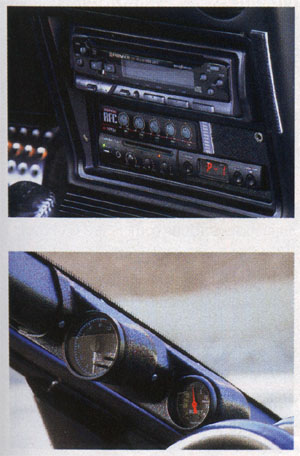 “I decided to upgrade the turbo [again] to make full use of the new wastegate.” After a quick long-distance call to Texas Turbo, a “Frankenstein Level 2” turbocharger was on the way. Of course, swapping turbos and wastegates isn’t as easy as it sounds. with different flanges and wastegate configurations, Road Race Engineering had to craft a custom 3-inch down-pipe and exhaust manifold.While all this fabrication sounds like a lot of work, there is no doubting its merits. Empirically, the new turbo should be capable of generating more airflow, with less heat and with reduced exhaust back-pressure levels—all of which translate to more horsepower. However, airflow is useless without sufficient fuel delivery and properly timed spark advance.In an effort to meet both requirements, Gray installed a TechnoMotive ECU upgrade. Featuring a number of welcome EPROM tweaks, this cost-effective upgrade removed the boost and fuel cut in addition to raising the rev limiter. As an added bonus, the stock low-resolution, dashboard-mounted analog boost gauge can easily be configured to monitor air/fuel mixture, ignition timing, battery voltage or knock sensor output. Coupled with TechnoMotive’s optional data logging system, Gray is able to tune the car for maximum power with minimal drivability compromises. In fact, despite driving a car capable of whipping off mid-11-second passes, Gray claims to record better-than-stock fuel economy (25/20 hwy/city to be exact).
“I decided to upgrade the turbo [again] to make full use of the new wastegate.” After a quick long-distance call to Texas Turbo, a “Frankenstein Level 2” turbocharger was on the way. Of course, swapping turbos and wastegates isn’t as easy as it sounds. with different flanges and wastegate configurations, Road Race Engineering had to craft a custom 3-inch down-pipe and exhaust manifold.While all this fabrication sounds like a lot of work, there is no doubting its merits. Empirically, the new turbo should be capable of generating more airflow, with less heat and with reduced exhaust back-pressure levels—all of which translate to more horsepower. However, airflow is useless without sufficient fuel delivery and properly timed spark advance.In an effort to meet both requirements, Gray installed a TechnoMotive ECU upgrade. Featuring a number of welcome EPROM tweaks, this cost-effective upgrade removed the boost and fuel cut in addition to raising the rev limiter. As an added bonus, the stock low-resolution, dashboard-mounted analog boost gauge can easily be configured to monitor air/fuel mixture, ignition timing, battery voltage or knock sensor output. Coupled with TechnoMotive’s optional data logging system, Gray is able to tune the car for maximum power with minimal drivability compromises. In fact, despite driving a car capable of whipping off mid-11-second passes, Gray claims to record better-than-stock fuel economy (25/20 hwy/city to be exact).
Like the engine, the rest of the car has been set up with both street and track use in mind. For a clutch, Gray chose a sturdy Advanced Clutch Technology 2,600 ft./lbs. pressure plate with a streetable organic friction disk. To strengthen the Eclipse’s notoriously fragile drivetrain, a Cusco clutch-pack center limited slip differential was installed. Supporting all four corners are GAB Super HP shock absorbers with 2.5-inch race springs and adjustable threaded spring perches from Ground Control. To ameliorate some of the Eclipse’s nose-heavy handling balance, Gray installed a 1.25-inch rear anti-roll bar from Suspension Techniques. And of course, a good road racing suspension wouldn’t be complete without a sticky set of R compound tires.
So how does it drive? Ridiculously well, that’s how. With a 0-to-60 mph sprint taking a mere (and official) 3.8 seconds, Gray’s Eclipse is one of the quickest cars SCC has ever tested. Quite remarkable ending for a formerly pedestrian go-getter.
Scot Gray’s Eclipse GSX Featured on Overboost.com
Scot’s GSX just got shot for SCC magazine and will be coming out next month there. Here it is on www.overboost.com right now:
1994 Mitsubishi Eclipse GSX
8/25/2000
John C. Naderi
Throughout the DSM circles and chat forums the tales surrounding this car (and its owner’s prodigious driving talents) have grown to mythical proportions. We know this because our web architect is the proud owner of our Project Eclipse and he constantly regales us with starry-eyed stories about this car’s exploits. We’ve heard many different accounts of this car and driver manhandling Porsches, Ferraris, Vipers and ‘Vettes on strip and street circuits. With this in mind, we nervously ventured out for an appointment with the man who belongs to this legendary machine. Upon our arrival we half-expected to find a Thor-like gladiator standing next to the Batmobile in front of some fog-enshrouded castle.
What we found was actually a mild-mannered Scot Gray standing in front of his equally mild-mannered 1994 Mitsubishi Eclipse GSX. After we completed our photo session Scot agreed to take us for a “relaxing” drive through the hills by his home. Once behind the wheel Scot quickly shed his Bruce Wayne image. Straight line acceleration runs are not really dramatic affairs as the all-wheel drive delivers you to warp speed in the same fluid fashion as the Millennium Falcon. But it was through the twisties that both the Eclipse and Scot’s tremendous driving talent shone through. We’ve had the opportunity to be both pilot and passenger in some of the most powerful race and street machines on every circuit from Willow Springs to the Nürburgring but nothing could have prepared us for this ride. “I’ve been to Skip Barber’s school and I’ve put the car through over 120 track sessions,” Scot told us nonchalantly. This was not cocky bragging on his part but rather something he probably says to alleviate passengers before reducing them to frightened, whimpering sacks of limp flesh.
Our brief ride with Scot confirmed the many fantastic tales we’ve heard so many times before. We’re obliged to report that both the car and driver, do indeed live up to the hype. Through a series of second and third gear hairpins and sweepers we experienced firsthand the Eclipse’s incredible adhesion and slot car-like transitions. “You have to drive it brave,” Scot says in terms of the GSX’s quirky AWD demeanor. In order to demonstrate Scot trails the throttle into a hard left and we begin to plow directly into the side of a rather solid looking mountain face – it takes a heavy right foot to bring things back under control. During a recent paper magazine test (one which the little black DSM dominated in virtually every category) even the highly-skilled automotive journalists couldn’t get a handle on the Eclipse – as indicated by the heavily “chunked” front tires (those who can’t drive cars, write about them-OVB).
But it was on Malibu’s famed Kanan Road that we felt the true power of the beast. We happened upon a Fly Yellow Ferrari 360 Modena and a black 911 Turbo (993). As we slowly came around the pair of supercars Scot blipped the throttle a couple of times but the Ferrari owner wouldn’t bite (probably one of those Hollywood types more concerned with how he looks in the car as opposed to how he drives it-OVB). But for a brief moment the Turbo driver gave chase – we say “brief” because in that moment Scot reduced the Porsche to a tiny spec in the rear view mirror – a mirror that reads – “Objects in mirror are getting their asses kicked (perhaps Scot’s only concession to ego, albeit well-deserved-OVB).” Even if the Stuttgart Wunderkind had run full-out it would have still been futile. Look at these numbers:
|
Car Comparisons
|
||||||
|
0-60 mph
|
0-100 mph
|
1/4-mile
|
top speed,
mph |
lateral g’s
|
hp
|
|
| Ferrari 360 Modena |
4.6
|
11.1
|
13.1 @ 110 mph
|
175 (gear limited)
|
0.92
|
395
|
| Porsche 911 Turbo (996) |
3.9
|
8.9
|
12.3 @ 116 mph
|
192 (gear limited)
|
0.93
|
415
|
| Scot Gray’s Eclipse |
3.6
|
8.9
|
11.92 @116.4 mph
|
178 (gear limited)
|
1.06
|
490
|
But when the weather outside turns frightful the Porsche and the Ferrari may turn tails (literally) but with a flick of the wipers the AWD Eclipse is ready to go. Zero-to-sixty in the wet still comes up in 3.9 clicks and on a puddle-laden skidpad the little black coupe will still hold 1.02 g’s. The 490 horses under the hood equates to 412 when measured on the Dynojet 248C. While this is the most recent dyno sheet but Scot tells us that the car makes noticeably more power now. So how did Scot Gray manage to turn his Eclipse into the supercar stalker you see here?
As the song lyrics go, Scot gets by with a little help from his friends. The Eclipse’s monumental performance upgrades are courtesy of Road/Race Engineering. It is safe to say that the crew at this Huntington Beach, California shop knows a little something about Diamond Star cars. The Road/Race crew is revered as god-like when it comes to DSM tuning. These guys know all the tricks and they utilized them on Scot’s Eclipse. The factory head was ported and polished and treated to an HKS Metal Head Gasket and ARP Head Studs. A ’95-Spec exhaust manifold was ported as was the throttle body elbow and MAF Sensor. The stock bump sticks were tossed in favor of a pair of Web Cam units. But the real gem under the hood is the Frankenstein Stage 2 Turbo from Texas Turbo. The high-output turbine is complemented by a “crushed” stock blow-off valve, TIAL External Wastegate, HKS front mount intercooler, an Intercooler sprayer (custom-fabricated with help from Home Depot), RRE intercooler piping, Buschur Racing polished upper intercooler piping and a 3-inch RRE O2 Eliminator Downpipe.
Big turbos produce big heat and since the massive HKS front mount occupies such a large frontal area RRE supplied one of its “Racing” drop in radiator replacements and Scot fabricated a clever ducting system to direct fresh air to the engine bay. In addition to extra cooling big turbo set-ups require extra fuel and this was accomplished with a CarTech External Adjustable Fuel Pressure Regulator, Blitz 660cc injectors and a hardwired Walbro 255Lph HP in-tank fuel pump. Waste gases exit through a Random Technology 3-inch high-flow catalytic converter to a 3-inch RRE exhaust with Dynomax SuperTurbo muffler.
Engine management is assisted by a TechnoMotive Stage III ECU and Data Logger, A’PEXi AFC and an MSD DIS-2 Ignition Amplifier and 2 Stage Rev Limiter. Scot monitors the engine vitals with a GReddy Turbo Timer and Digital EGT gauge and an AutoMeter boost gauge. And, believe it or not, Scot uses a Radio Shack intake temperature gauge, narrow range LED A/F meter and an A/F ratio digital-volt meter.
Scot enlists a wide variety or tire/wheel combinations to help him create supercar stats on the streets, strips and circuits of Southern California. On the street Scot rolls on SSR Integrals in a 17×7 fitment with Bridgestone Potenza rubber. For the drag strip he uses his stock 16-inch alloys with Dunlop SP8000s inflated to 20 psi. Scot tells us this provides a relatively low traction combination so the car will spin all four tires briefly off the line and help spool the turbo (good-OVB) and not snap the axles (bad-OVB). Four hundred and ninety horsepower and AWD make for intense drivetrain abuse. The Eclipse’s five-speed tranny is beefed up with a Quaife Torsen-style center differential and an ACT 2600 Street Disc clutch with a lightened flywheel (Scot says even this clutch is prone to slippage). For circuit racing on a real track Scot’s current choice is 16-inch Prime 5-star wheels with Kumho VictoRacer V700 Rs or Toyo Proxes RA1s – depending on what is available. But Scot claims these wheels are ridiculously heavy and really ugly (his wording not ours – OVB legal department), but hold air and fit on the car. He is planning to replace them with Kosei K1’s soon.
To create over 1 g of cornering capabilities Scot utilizes an RRE coil-over suspension with custom-valved Bilstein front struts and GAB Adjustable rear shocks. RRE’s own “Anti-toe” rear lower control arm modification and front Adjustable Camber Plates were also added. A Suspension Techniques rear antisway bar and Racer Design front and Extreme Motorsports rear strut tower braces help reduce chassis flex. To help shave speed rapidly Powerslot rotors with Axxis Metal Master pads and Goodridge stainless steel lines are also used.
With the talented Road/Race team Scot has truly created one super car for much less than a supercar (with even more performance to boot). Beware exotic car owners, your large checkbooks can’t compensate for this little black beast and sooner or later its owner will have his sights set on you. For more info visit Scot’s site at www.dsmporn.com
| Car Specs | |
| 1994 Mitsubishi Eclipse GSX | |
| Engine Type: | DOHC 16-valve four-cylinder |
| Engine Mods: | Ported and polished factory head; HKS Metal Head Gasket; ARP Head Studs; Ported ’95-Spec exhaust manifold; ported throttle body elbow and MAF Sensor; Web Cams 264 Intake, 272 Exhaust; S&B Air Filter; Texas Turbo Frankenstein Stage 2 Turbo, Ported, 10 Degree Clip; “crushed” stock Blow-off valve; TIAL External Wastegate; HKS front mount intercooler; Intercooler sprayer (Home Depot); RRE intercooler piping; Buschur Racing Polished upper intercooler piping; 3-inch RRE O2 Eliminator Downpipe; MSD DIS-2 Ignition Amplifier and 2 Stage Rev Limiter; Magnecore plug wires; NGK BP7E plugs; Ported O2 sensor housing; RRE “Racing” drop in radiator replacement; CarTech External Adjustable Fuel Pressure Regulator; Walbro 255Lph HP in-tank fuel pump (Hardwired); Blitz 660cc injectors; Random Technology 3-inch high-flow catalytic converter; 3-inch RRE exhaust with Dynomax SuperTurbo muffler. |
| Engine Management: | TechnoMotive Stage III ECU (No Fuel Cut) TechnoMotive Data Logger; A’PEXi AFC |
| Drivetrain: | Five-speed manual transmission with Redline MTL; Quaife Torsen-style center differential with Redline Shock-Proof; ACT 2600 Street Disc Clutch with lightened flywheel |
| Suspension: | RRE coil-over suspension (375 lbs front, 425 lbs rear) with custom-valved Bilstein front struts and GAB Adjustable rear shocks; RRE “Anti-toe” rear lower control arm modification to; RRE front Adjustable Camber Plates with upgraded Perches; Suspension Techniques 1.25-inch rear antisway bar with polyurethane bushings; Racer Design front and Extreme Motorsports rear strut tower braces |
| Brakes: | Powerslot rotors; Axxis Metal Master pads; Goodridge stainless steel lines |
| Wheels: | Street – SSR Integral 17×7; Circuit – Prime 5-Star 16×7; Drag – ’94-Spec Mitsubishi Eclipse GSX 16×6 |
| Tires: | Street – Bridgestone Potenza RE730 All-Season 225/45ZR17; Circuit – Kumho VictoRacer V700 R compound or Toyo Proxes RA1 tires 225/50R16; Drag – Dunlop SP8000 205/55R16 |
| Exterior Mods: | 1997 Montero Sport Mitsubishi logo; clear turn signal lenses |
| Interior Mods: | Corbeau Targa Racing Seats and Schroth AutoControl Harnesses; RAZO billet aluminum pedal set |
| Mobiletronics: | GReddy Turbo Timer and Digital EGT gauge; AutoMeter Boost gauge; Radio Shack intake temperature gauge; narrow range LED A/F Meter (.70-.95 Volt); A/F Ratio digital-volt meter; Pioneer DEN-245 head unit |
| Sources | |
| DSM Porn Road Race Engineering Technomotive ECUs |
Tijuana Gran Prix – March 1999 – Tijuana, Mexico
TIJUANA ,March 13-14- We brought the Black Road/Race Eclipse to Tijuana to race in the PRO BORDER SERIES. Competitors from NASA,PRO and CAS sports car racers attended. The weekend was sunny and mild in TJ. We took to the track Saturday fro practice and qualifying. Both sessions went well. The Road/Race JEMFX Mitsubishi responded well the the modifications we made in the off season. The addition of an oil cooler and remote filter assembly drastically improved our engine cooling as well as two more fans on the radiator. We also added added a boost activated water spray system for the radiator.
Robert Tallini again drove the car for us. He qualified on the outside of the first row for Saturday’s Heat Race. Second in qualifying, the other five out of six cars were 6-cylinder Porsches. The green flag dropped and Tallini took the Road/Race Eclipse right to the front, leading from lap one to finish! The car performed well although brakes were still an issue with our car’s overall performance. Winning this race put us on the pole for Sunday’s main event.
Sunday’s schedule consisted of a warm up session and a main event. During our warm-up we took it easy. Tallini ran most of the session just to check gauges and feel the car out for the main event. One interesting development occurred during warm-up. Ty Tipton, driving a 1.8 Honda Civic set fastest time in warm-ups. He had mechanical problems on Saturday. His times were a bit faster than the last times we recorded and had us a little worried. In the main event, we shot out into the lead and pulled from the field. Tipton’s times were no fluke though. He cut his way through traffic and stormed up behind Tallini and started to ride our bumper. We had a little more left though. After sizing up Tipton, he used the overtake boost button on the PRofec A, pushed harder everywhere, and pulled out to a comfortable margin. Tallini took the overall win in our car, beating three classes of cars varying from 4 cylinders to V-8s!
Mexican fans really appreciated the exciting race and our efforts. Tallini returned the favor laying down some smoking burnouts for the enthusiastic crowd. We also learned a lot from these races and look forward the the next round of development for our car. We plan on running the car at a variety of events this year in the U.S. and Mexico. We would like to thank everyone who helps us, JEM/FX, Ronal Wheels, GReddy, and Toyo Tires. We can always use a hand.
Downtown LA Motors Street Race – September 5-7 1998
The PRO Racing Series features late model production based sports cars specially modified for racing. Competitors race in one of five class structures based on the performance potential of the cars. Makes and models in the series are Porsche, Ferrari, Acura NSX. Ford Mustang, Corvette, Dodge Viper, BMW, and more. Tops speed of the cars can reach over 175mph on the faster tracks. PRO Racing Series accepts only established race drivers. There is no room for the novice here.
Qualifying sprints on Saturday. On Sunday the PRO Racing Series will see its diverse field of sports cars engage in a one-hour “mini” enduro. As a result of mandatory fuel stops for all drivers, pit action and lead changes will abound. You’ll never know who will win till the checkered flag drops and the Ford L.A. Street Race double s-turns on the way to the finish line.
The PRO Racing series includes race events in such diverse places as Tijuana Mexico, Las Vegas, Laguna Seca, Willow Springs, and of course, the LA Street Race.
We had the opportunity to race with PRO Racing Group on a road course laid out around the Sports Arena in Exposition Park. Our 1992 GST is classified in the P4 class. The 1.1 mile course runs through part of the parking lot and out onto Figueroa St. The main event for the weekend was a 125-mile NASCAR Featherlite Southwest Tour race
This was Rob’s first race in the RRE GST. Saturday we had a lot of problems with overheating the brakes. We are running the AWD dual piston calipers. We had run the car mostly at Willow Springs on the big track and braking had never been an issue there. Our Porterfield R4 compound pads stopped well enough but they are crumbling from the excessive heat. The course is made up of short straights and sharp turns. There is nowhere for the brakes to cool off.
On race day they did a cool Le Mans style start. As you can imagine it was pretty much pandemonium. The drivers all have their cars lined backed up to the edge of the track at a 45 degree angle. Motor off. When the green flag drops you start the motor and get going as fast as you can. I dont know why it takes big burly Porsches so long to get up and going but Rob fired up and jumped out in front of a bunch of them. They eventually got back by but the photo of him leading all those cars on the first lap was priceless!
Sunday the race was nothing but disaster. Since the PRO Racing group we run with are second fiddle to the Nascar race, we just get the mushroom treatment. Out practice times get cut to start with. Then the NASCAR race turns into a demolition derby on the short tight course. It is pretty much run under a constant yellow flag. It runs late and we are starting our race almost in the dark.
We changed out the calipers and pads overnight, added some better fluid and rigged up some ducting. Sunday they change the start to where you have the motor already running. Green flag and go. Then they decide to call the race short since their fire permit times out. Some of the drivers are pitting, some are still out and they just call the race. We have no idea how we did,
The mandatory pit stop really did us in. We came to a stop in the pits and the calipers burst into flames. The seals pretty much melted right out and the fluid caught fire on the red hot rotors. There just wasn’t enough track to do any kind of cool down lap and stay competitive with the brake setup we had.
We learned a ton from this race. It was a totally different experience racing in front of real people instead of rabbits and coyotes in the desert.


